Abstract
The sudden increase in global energy demand has prompted the integration of Artificial Intelligence and the Internet of Things into the utility grid. The synergy of Artificial Intelligence and the Internet of Things in renewable energy sources has emerged as a promising solution for the development of smart grids and a transformative catalyst that restructures centralized power systems into resilient and sustainable systems. The state-of-the-art of the Internet of Things and Artificial Intelligence is presented in this paper to support the design, planning, operation, management and optimization of renewable energy-based power systems. This paper outlines the benefits of smart and resilient energy systems and the contributions of the Internet of Things across several applications, devices and networks. Artificial Intelligence can be utilized for predictive maintenance, demand-side management, fault detection, forecasting and scheduling. This paper highlights crucial future research directions aimed at overcoming the challenges that are associated with the adoption of emerging technologies in the power system by focusing on market policy and regulation and the human-centric and ethical aspects of Artificial Intelligence and the Internet of Things. The outcomes of this study can be used by policymakers, researchers and development agencies to improve global access to electricity and accelerate the development of sustainable energy systems.
1. Introduction
The global energy crisis caused by the fluctuation of fossil fuels prices, population growth, aging infrastructure, supply chain disruption, the high standard of living and poor electricity infrastructure has considerably forced many manufacturing companies to reduce production, increase inflation, slow down economic activities, increase energy prices and create economic hardship for citizens [1]. The global energy crisis can be addressed by using renewable energy sources (RESs), the formulation of supportive government policies, the diversification of energy supply sources and energy market reforms and the strengthening of energy reserves [2]. The pressing need to resolve the issues of climate change, energy security and economic stability has led to the adoption of sustainable energy solutions and policies that ensure reliable energy access while reducing climate risks. The shift in fossil fuels to renewable energy as an alternative power solution can be used to restructure power systems with the environment, economy and societal value chain. This offers several benefits across different sectors of the economy such as improved energy independence and security, reduced cost of energy, and supporting technological innovation, community empowerment and energy access [3]. The proactive role played by each renewable energy source in the global energy transition is vital for the development of sustainable energy systems [4,5]. The transition from brown energy technologies to green energy technologies has become a multidimensional solution that can be used to address perilous environmental challenges, stimulate economic growth and improve the global social well-being of people. It encourages large investments in research and development which results in improvements of electric storage system and grid integration and efficiency. It is obvious that fossil fuels have been crucial to the development of the modern economy by powering the global economy and supporting technological advancements that have boosted commercial and industrial activities.
According to the report of the Renewables 2025 Global Status, fossil fuels accounted for 68% of the global energy supply. The report shows that the majority of the global primary energy supply emanated from fossil fuels to satisfy energy demand that grew by 4.3% in 2024. This demonstrates that RESs accounted for approximately 32% of the world’s power supply in 2024, as shown in Figure 1a [6]. The International Energy Agency (IEA) report of 2025 also indicates that renewable energy accounted for the largest share of the growth in global energy supply with about 38%, followed by natural gas (28%), coal (15%), oil (11%) and nuclear (8%) as presented in Figure 1b [7]. The astounding record of the IEA indicates a significant growth and global shift from brown technologies to sustainable and green energy technologies that are being aided by technological advancements, environmental concerns and governmental regulations. The combustion of fossil fuels for power generation applications has led to significantly increased greenhouse gas (GHG) emissions, acid rain, increased healthcare costs, biodiversity loss, ocean acidification, global warming and climate change [8]. In view of this, fossil fuel-based power plants are gradually being replaced by cleaner and sustainable energy systems that can strike a balance between environmental preservation and financial growth [9].
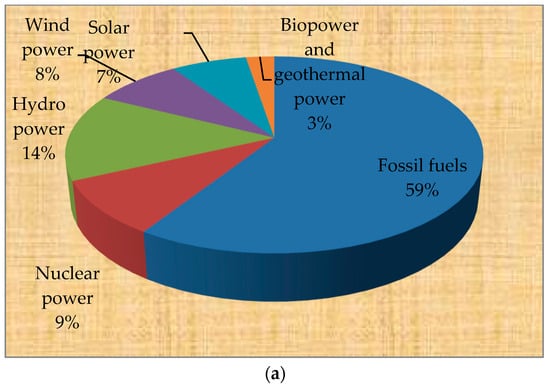
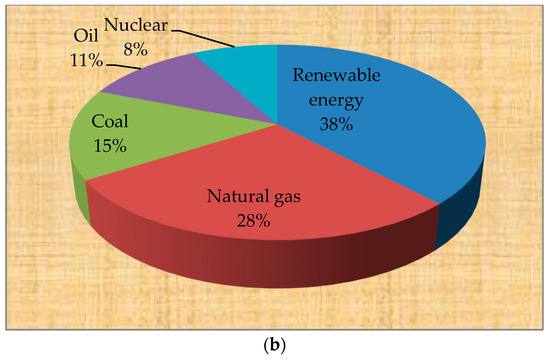
Figure 1.
(a) Electricity generation by several energy sources in 2024 and (b) share of energy supply growth from several sources in 2024.
The effective utilization of green energy technologies to improve access to electricity and reduce GHG emissions is limited owing to the intermittent nature of RESs [10]. The power generated by photovoltaic (PV) systems and wind turbines (WTs) is extremely hard to predict with precision at any given time due to the inherent challenges of RESs [11]. The intermittent nature of RESs is a significant challenge that severely hinders the maintenance of a stable and reliable electrical power supply at the load points [12]. It can also cause frequency fluctuations, voltage instability and reduced inertia of conventional power plants. The challenges of RESs in the power system can be mitigated by the implementation of several strategies such as Artificial Intelligence (AI) algorithms, Internet of Things (IoT) devices, smart grids, battery systems and demand-side management [13,14]. The electric storage systems can be used in grid-connected or standalone power systems to minimize the effects of uncertainty that are associated with RESs. They be used to store excess energy during the peak renewable generation and inject it back to the utility grid when the costs of energy are high [15]. RESs have great potential for sustainable energy but their intrinsic qualities provide serious obstacles to the stability and reliability of the power system [16]. AI and IoT are the components of smart grids and advanced grid management systems that can provide innovative and potential solutions to surmount the inherent challenges of RESs [17]. The convergence of IoT and AI can be utilized to transform traditional power systems into a sustainable and reliable system by using the enormous potential of renewable energy sources while effectively managing their inherent variability [18]. IoT devices support smart grid systems that balance energy loads, reduce GHG pollutants and optimize energy distribution [19]. The IoT with smart grid features supports manual switching between RESs and fossil fuel-based conventional power plants to facilitate a continuous power supply at consumer centers. This switching makes it easier for smart grids to accommodate the variable nature of RESs and allow an uninterrupted power supply to the customers [20].
The traditional power system that was initially built for centralized energy systems and a unidirectional flow of energy finds it difficult to satisfy the load demand of emerging power systems. The proliferation of distributed energy resources (DERs) in the modern power system has led to a sudden transition from a centralized power system to decentralized power with the adoption of bidirectional energy management [21,22]. This transformation is facilitated by using AI, IoT, smart grid features and electric storage systems to transform a decentralized energy system into an adaptive, intelligent and interconnected network. The transformation can be accomplished by allowing a higher penetration of DERs, improving grid reliability, reducing operational costs and empowering individuals to participate in the energy market. The IoT is the nervous system of a decentralized energy system that allows AI to function effectively. It collects vital signs, communicates the necessary information and allows the operations of DERs to be controlled through an automated system. The intermittent nature of wind speed and solar irradiance can be overcome by using modern technologies for the stabilization of the utility grid and the utilization of RESs [23]. The convergence of IoT devices and AI in grid-connected or standalone hybrid renewable energy systems allows producers and prosumers to satisfy the load demand of consumers through the coordination of electrical power obtained from different RESs [24]. The IoT has been playing a proactive role in the optimization of distributed energy resources (DERs) in centralized and decentralized power systems by using real-time monitoring, automation and smart devices to enhance the efficiency and sustainability of variable RESs like solar and wind [15,25]. The emergence of smart grids through IoT has increased the usage of RESs for power generation applications [26]. It provides incredible advantages in terms of power consumption monitoring and real-time alerting that allow distribution network operators to integrate RESs into their distribution systems [27,28]. The applications of IoT devices and AI models have been deployed in several sectors of the economy to enhance automation, improve efficiency and support data-driven policies [29].
The successful application of RESs in the traditional power system is hindered by numerous factors such as performance inefficiencies, the variability of load demand, a lack of predictability, integration complexity within the utility grid and a lack of real-time responsiveness [30,31]. The challenges can be addressed by using the convergence of IoT and AI that provides a robust and intelligent solution for the monitoring, control and optimization of renewable energy-based power infrastructure [21]. The combination of the IoT and AI is crucial for the transformation of renewable energy systems by providing clean, affordable, reliable and sustainable energy at the load points [32]. The performance of a conventional power system can be optimized with the integration of AI and IoT as well as the penetration of RESs through the energy mix [33]. The combined operation of AI and IoT plays an important role in minimizing GHG emissions and mitigating climate change by promoting the application of RESs in the utility grid [19,34,35].
The convergence of IoT and AI to improve the performance of RESs in a conventional power system has been globally acknowledged as an emerging field of research and development. This literature review covers four key areas such as IoT devices for data acquisition and control, AI models for forecasting and optimization, AI models for predictive maintenance and the integration of AI algorithms and IoT devices for smart grid management. Ullah et al. [36] focused on IoT architecture and monitoring of smart grid systems with IoT devices. The authors also provided a comprehensive overview of the required technologies for the optimal operation of smart grid systems by laying more emphasis on the functions of sensors and communication systems. Balamurali et al. [37] presented the application of IoT for supervising and controlling the operation of a mobile solar pumping system that was designed for the efficient water management of modern agriculture practice. The outcomes of their study demonstrate the technical feasibility of utilizing sensors for the real-time management of smart irrigation systems with IoT. Liu et al. [38] applied AI to predicting the intermittent nature of wind resources for the optimal operation of energy systems. The authors presented a comprehensive review of several methods that can be used to forecast wind speed such as statistical models, long short-term memory networks, convolutional neural networks and artificial neural networks (ANNs). Kumar et al. [39] applied particle swarm optimization and genetic algorithms to position wind turbines and maximize their energy capturing and minimize their wake effects. The authors accomplished this task by utilizing predictive maintenance which is one of the important applications of AI in energy systems. Similarly, Pandit et al. [40] introduced predictive maintenance as one of the crucial factors that can be utilized for the reduction in operation and maintenance (O&M) costs of wind turbines. Zhang et al. [41] presented a detailed review of machine learning (ML) methods for wind turbine conditioning and monitoring. The authors provided several methods such as support vector machines (SVMs) and ANNs for the analysis of vibration, acoustic and thermal data from IoT sensors and the prediction of component failures. The outcomes of the study show that proactive maintenance strategies can be used to optimize the utilization of the power system.
Alaba et al. [42] carried out a comprehensive detailed study of IoT devices and AI algorithms and their uses in converting existing conventional power systems to intelligent power systems. The authors achieved this objective by mapping out the landscape of AI and IoT applications in smart grid systems and the significance of their collaboration for managing grid stability, demand response and energy trading. Similarly, Zahraoui et al. [43] performed a detailed analysis of microgrid systems and the effects of AI models on improving the resilience and efficiency of the power systems. Mbasso et al. [44] conducted a thorough review of the digital twin (DT) technique within the concept of an emerging energy system by utilizing real-time IoT data and AI to achieve scalable, intelligent and independent energy systems. The authors provided a comprehensive study of DT in RESs such as PV systems, hydro, wind turbines and hybrid renewable energy systems by focusing on the lifecycle assessment of energy systems. Bennagi et al. [45] carried out a comprehensive overview of AI in renewable energy resources, current technological advances of AI, the challenges of AI and the practical solutions of the challenges and expected trends of AI in the near future. Bello et al. [46] presented the application of AI in RESs to optimize energy efficiency, facilitate predictive maintenance and achieve real-time decision-making of an energy system. Moreover, Hussien et al. [47] presented a review of AI in RESs by focusing on their applications in the processing of foods and conservation. The authors also presented the limitations and prospects of AI in the future. Al-Shetwi et al. [48] investigated the application of IoT technology in power systems during power interruptions by concentrating on its structure, advantages, disadvantages and potential for the development of the future energy mix. Arshi et al. [49] presented the architecture, latest advancements and current challenges of IoT. The authors also delved into general applications of IoT in intelligent transportation, smart grids, smart cities, power generation and smart homes. Sankarananth et al. [50] applied a comprehensive approach that integrated AI and metaheuristic optimization techniques for projecting and controlling the operation of RESs in power systems. The outcomes of their study can be used to improve the availability of power supply and energy efficiency in both rural and urban areas. Pathare et al. [51] carried out a thorough analysis of the applications of IoT devices in smart grid systems with an emphasis on the challenges of RESs and implementations of strategic ways to overcome the challenges. A literature review of additional works in addition to those already described above is presented in Table 1.

Table 1.
Summary of studies on the integration of IoT and AI in renewable energy systems.
The potential of IoT and AI has not been fully tapped in areas of real-time processing, standardization, cyber security and deployment in underserved regions despite their several benefits. The literature review shows that several issues have not been adequately resolved in the research and practical integration of IoT and AI in RESs. The following research gaps are identified based on a thorough literature review carried out in the paper and further research to harness the potential of AI and IoT in RESs is proposed. Most existing studies are focused on the deployment of either AI or IoT in conventional and hybridized power systems without fully considering their combined synergism in the energy value chain. Standardized power systems that incorporate AI and IoT into RESs are not well studied. The scalability and interoperability challenges of AI models remain one of the significant barriers to improving the sustainability of energy through energy management systems. The real-time decision-making limitations of AI models under dynamic conditions, such as grid instability and the intermittent nature of RESs, have also been identified in several studies. Despite significant advancements in the integration of IoT and AI in renewable energy systems, cyber security risks and data governance have not been sufficiently addressed in the literature. There is a considerable knowledge gap in the academic research and embedded operations of AI and IoT models in the power system based on a thorough assessment of the state-of-the-art of the published work on RESs. The challenges of IoT and AI as well as research gaps identified from the literature can be addressed by using concerted efforts of academics, investors and legislators. The main objective of this study is to conduct a comprehensive review of the state-of-the-art of IoT and AI technologies and their significant potential in smart energy management systems. This study identifies current trends, challenges and opportunities of using AI and IoT in renewable energy-based power systems. This study proposes several research strategies that can support future research and development and address the challenges of AI and IoT devices. This paper’s contributions are listed as follows:
- i.
- The presentation of the state-of-the-art of IoT and AI and their roles in renewable energy-based smart grids.
- ii.
- An overview of AI techniques utilized in RESs for predictive maintenance, forecasting, optimization, grid management and demand-side management.
- iii.
- A review of the existing literature on IoT devices and communication technologies used for the management, control and monitoring of RESs.
- iv.
- The presentation of the benefits and applications of integrating IoT and AI into emerging power systems.
- v.
- The presentation of IoT and AI technologies that can be used to address inherent challenges of RESs such as the intermittency and unpredictability of wind speed and solar irradiance.
- vi.
- The provision of detailed contributions of IoT and AI strategies for the improvement of grid flexibility and the operational efficiency of the power system.
- vii.
- The presentation of pilot projects that demonstrate the implementation of IoT and AI technologies in RESs.
- viii.
- The presentation of emerging trends, challenges and areas of future study at the nexus of RESs, AI and IoT for academic research, industrial applications and policymakers.
The remaining parts of this paper are presented as follows: A comprehensive overview of IoT, architectural components and critical functions in data acquisition, and monitoring and control within renewable energy systems is presented in Section 2. An introduction to AI and its diverse roles in forecasting, optimizing grid management and predictive maintenance are outlined in Section 3. The synergy and integration of IoT and AI in renewable energy systems and the successful implementation of AI and IoT projects in RESs are presented in Section 4. The technical, economic, regulatory and societal challenges that hinder the full implementation of AI and IoT technologies in RESs and future research directions of AI and IoT in sustainable energy are presented in Section 5. The conclusion that consists of key findings and recommendations is presented in Section 6.
2. Internet of Things
IoT is a vast and transformative process that connects smart devices and other objects to a network [74,75]. It utilizes sensors, connectivity modules, processing units, power sources and user interfaces for data collection, transmission, processing and interaction with the physical world. IoT has successfully transformed the global energy system based on the following benefits: better control and automation, higher cost efficiency, smart grid management, balanced distributed systems, better transparent electricity utilization, efficient smart meters and supreme residential solutions. The applications of IoT encompass the following: smart cities, smart healthcare, smart homes, smart grids, smart transportation, smart environmental monitoring, smart agriculture and smart water management systems. IoT has emerged as a transformative technology that can be used across different sectors of the economy to improve automation processes, operations and services, remote monitoring, customer experiences, the optimization of resources, decision-making and optimal performance. The potential applications and benefits of IoT across different industries are presented in Table 2 [62,76,77,78,79]. Internet of Things is classified into five major categories such as consumer IoT (CIoT), commercial IoT, industrial IoT (IIoT), infrastructure IoT and medical IoT (IoMT) [15,80]. The visual representation of IoT types and key applications is preented in Figure 2.

Table 2.
Overview of IoT applications across multiple industries.
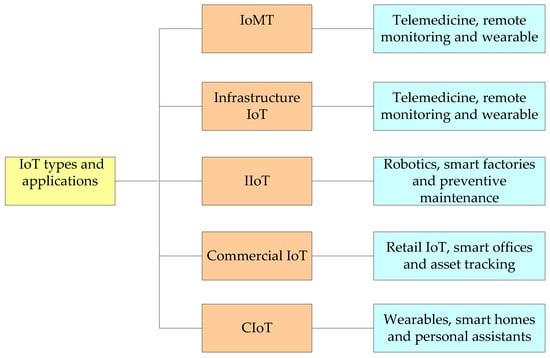
Figure 2.
Visual representation of IoT types and key applications.
It consists of several components that allow IoT to collect, transmit and act on data obtained from the environment. The components of IoT allow devices to connect, collect data and interact with each other. These components include sensors/devices, connectivity, data processing and user interfaces, which are presented in Figure 3. Sensors collect real-time data from the environment, connectivity allows communication between devices, data processing allows the analysis and interpretation of the information and user interfaces allow a human operator to interact with the system.
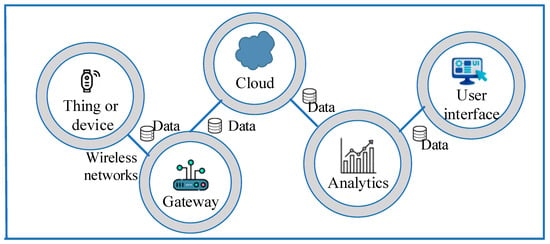
Figure 3.
Core components of IoT: devices, cloud, gateway, analytics and user interface.
2.1. Architectures of Internet of Things
An IoT architecture is the structured framework that explains the interaction of IoT systems such as layers, communication processes and components. It coordinates the collection, transmission, processing and delivery of data obtained from IoT devices at connected platforms. The IoT architecture is designed to facilitate the flow of data from the device layer to the application layer. It offers an interactive platform for the application of IoT devices and ensures that all of the components of the IoT system operate together in a smooth manner. IoT architecture is the mainstay of IoT systems that describes how technologies, applications and IoT devices work together to provide the intended practical applications. IoT architecture is classified into three-layer architecture, five-layer architecture and cloud fog edge computing architecture based on layer-based architecture; application domain and purpose. The three types of IoT architectures are presented in Figure 4 by using the following layers: perception, network, processing, application, business, cloud, fog and edge. The comparison of IoT architectures is based on the functional flow from sensors to applications. The abovementioned layers based on the architectures of IoT are compared on the basis of components, strengths, weaknesses and applications and presented in Table 3.
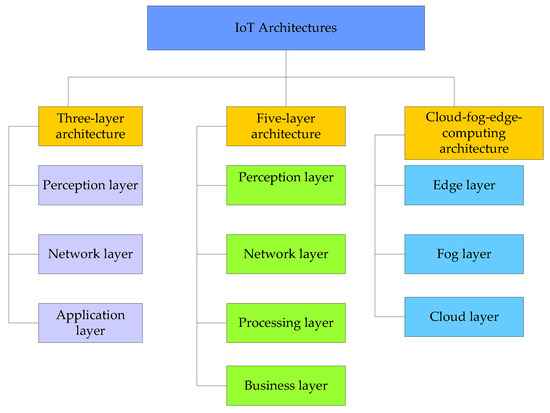
Figure 4.
Classification of an IoT architecture.

Table 3.
Comparison of IoT architectures in terms of strengths, weaknesses, applications and layers.
2.2. Internet of Things in Renewable Energy Systems
The integration of IoT into renewable energy systems has globally been acknowledged as a transformative development to change conventional power systems to decentralized power systems with emerging features. The efficient management and integration of RESs into the utility grid is facilitated by IoT devices that support the data analysis, real-time monitoring and automation of the associated components of the power system [81]. The cost-effectiveness and efficiency of RESs have increased recently owing to technological advancement and the high demand for clean and affordable energy. The integration of IoT in renewable energy technologies has considerably transformed how wind or solar farm operators monitor and collect data and maintain and interact with PV systems, wind turbines and associated components. The performance of RESs in centralized and decentralized power systems has been increased by IoT devices that provide real-time data and the advanced analysis of energy generation and usage [33]. The integration of IoT technologies in distribution networks leads to the balance of power generation and load demand and an improvement of the overall efficiency of the system [19,24]. IoT can be used to improve the incorporation of RESs into the utility grid by allowing data analysis and real-time monitoring for the optimization of the power system [82]. The incorporation of IoT devices into RESs plays a crucial role in the transformation of brown energy technologies into green energy technologies by providing real-time communication, monitoring, control and automation that ensure the efficient and sustainable utilization of renewable energy resources. The real-time role of IoT in renewable energy integration is presented in Figure 5.
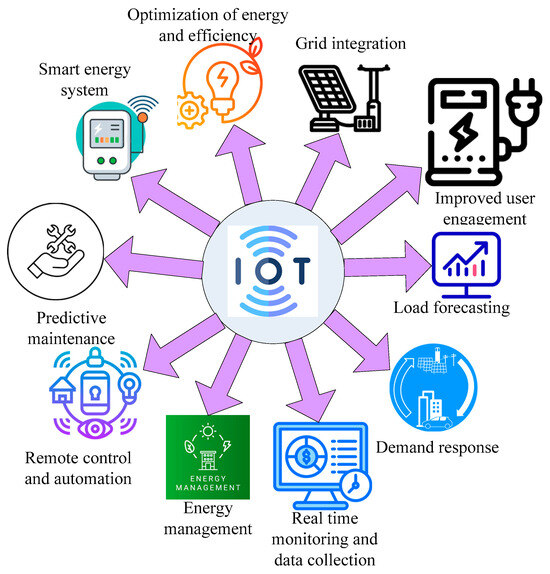
Figure 5.
Real-time role of IoT in supporting renewable energy integration.
2.3. Impact of IoT on Renewable Energy Systems
IoT has a profound and transformative impact on RESs by introducing real-time data collection, remote control, predictive analytics and automated decision-making [24,26,29]. The overall contribution of RESs to the energy mix can be increased by using IoT that monitors, manages and optimizes power system [16]. The integration of IoT in RESs has considerable impacts on the power system such as a 15% improvement in energy generation, 35–50% reduction in unscheduled downtimes, 30–40% reduction in maintenance cost, 5–20% reduction in peak demand, 59.1% reduction in forecasting error, 19–25% increase in usable renewable generation, 64% reduction in supply and demand mismatch, 15–20% curtailment reduction, 3–6% reduction in distribution system losses, 3–8% increase in usable storage efficiency of battery system, reduction in energy losses, 2–5% increase in net annual energy yield of wind turbines, 5–12% improvement in solar system annual energy yield and 5–30% reduction in operating cost [69,74,83,84,85,86]. IoT devices can be used by the operators of a solar farm to optimize the inclination angle of PV panels, maximizing solar irradiance exposure and energy conversion. The health status of each PV panel can be monitored by IoT devices that promptly address the technical challenges of RESs. IoT technologies are used to monitor wind conditions and turbine operations in real time by adjusting turbine speeds and positions to capture optimal wind energy. The transformative role of RESs in the conventional power system can be improved with the application of the Internet of Things. It is utilized in the power system to transform renewable energy systems from static, unreliable, inefficient, consumer-passive and fragile systems into intelligent, adaptive, consumer-driven, resilient and sustainable systems. The impacts of IoT on renewable energy systems can be assessed by comparing some key performance indicators before the integration of IoT and after the integration of IoT devices into the power system. The impacts of IoT on renewable energy systems are presented in Table 4 [16,87,88,89].

Table 4.
Overview of IoT contributions to renewable energy systems.
2.4. Data Acquisition and Monitoring in Renewable Energy Systems
IoT data acquisition and monitoring comprises the collection of data from sensors and other devices that are connected to the internet [29]. It can be used for the efficient, reliable and sustainable operation of power systems as well as monitoring the entire energy value chain from the generation sources to the load points. This leads to improved efficiency, cost savings, better decision-making and enhanced consumer comfort [90]. This technology is utilized in various applications such as smart homes, smart cities, industrial automation, environmental monitoring and research. The IoT-enabled data acquisition and monitoring system can be used for the monitoring of temperature, pressure, humidity and energy consumption, data collection and analysis, the remote control of devices and systems, process automation and environmental monitoring [33]. Data acquisition and monitoring can be used to improve the optimal performance, energy forecasting and fault detection of the power system [34]. It plays a vital role in tracking the performance of a PV system, wind turbine output, fault detection, predictive maintenance, load balancing and battery charge/discharge energy [27]. Data acquisition and monitoring is a process that can be used to assess the performance of renewable energy systems based on the analysis of data collected from sensors and communication technologies. This involves the measurement of technical parameters such as meteorological conditions, electrical parameters and other relevant parameters. The framework that describes data acquisition and monitoring in renewable energy systems is presented in Figure 6. Sensors are installed on RESs and battery storage systems to collect real-time parameters such as irradiance, wind speed, wind direction, power output, state of charge, voltage, current, temperature and load demand. These physical phenomena are converted to electrical signals by the sensors installed on the RESs and battery storage system. The raw data obtained from the sensors are filtered and cleaned up before they are digitized and packaged into structured data for transmission to make them suitable for data acquisition. IoT devices collect and transmit real-time data through wireless and wired communication systems. The data is transmitted to a central system using communication systems such as Wi-Fi, Zigbee, LoRa, NB-IoT, GSM/4G/5G, Ethernet and RS485 [91]. The operators of the systems can access real-time data such as energy generation, energy consumption patterns and historical data reports on a dashboard or mobile applications.
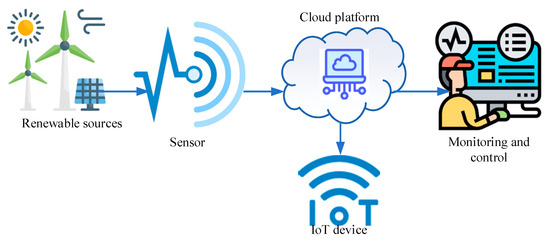
Figure 6.
Framework for data collection and monitoring of renewable energy systems.
2.5. Real-Time Performance Monitoring of Renewable Energy System Using IoT
Real-time monitoring is a process that consist of sensors, IoT devices and data analytics tools for the observation and measurement of key performance parameters of PV panels, wind turbines, small hydro and battery system such as temperature, pressure, solar irradiance, water head and wind speed in real time [92]. The real-time monitoring of renewable energy systems provides immediate insights into impending conditions of power systems and allows the maintenance teams to make quick decisions and detect the problems before leading to catastrophic failures. The operators of a utility grid can enhance the proactive maintenance efforts, address inefficiencies and improve the overall system reliability of their assets by using real-time performance monitoring. The real-time monitoring of renewable energy resources is a powerful tool that can be used by the power system operator to stay ahead of potential failures, improve efficiency and reduce operation and maintenance costs. The operators of the utility grid can optimize maintenance schedules and improve the asset reliability of their systems by providing continuous insight into asset performance. Real-time monitoring can be used for the early detection of problems that deviate from normal operating conditions, improving the decision-making of organizations. The early identification of the wear and tear of the power system components through continuous monitoring can increase the longevity of the asset. The real-time monitoring of renewable energy with sensors, an IoT gateway, a cloud platform, a monitoring dashboard and remote access is presented in Figure 7.
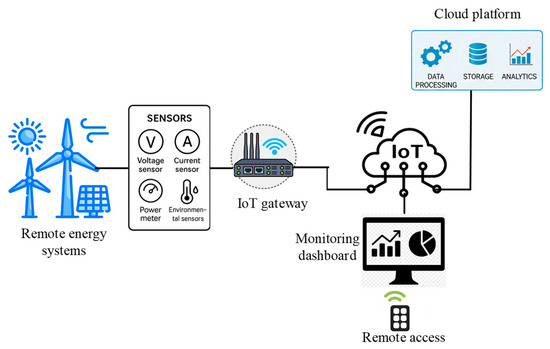
Figure 7.
Real-time monitoring of renewable energy system using IoT.
2.6. Automation of Processes for Efficiency and Safety
The integration of IoT into RESs has changed the landscape of renewable energy generation by increasing efficiency, optimizing performance and enhancing the sustainability of the power system [93]. The automation processes to enhance the efficiency and safety of power systems can be achieved by integrating smart sensors, advanced analytics and real-time monitoring devices into power systems. The exigency of efficient distribution networks is paramount with the global adoption of green energy technologies for power generation applications. Power producers or prosumers can enhance the performance efficiency and power output capability of their systems by using smart devices and IoT technologies. IoT sensors are incorporated into the power system to analyze the patterns of data and forecast equipment failures before their occurrence [94]. This would ultimately reduce downtimes, minimize maintenance costs and increase the lifetime of renewable energy components. The sensors of IoT can be used in RESs to monitor energy flow, identify irregularities and modify distribution parameters in real time. At the same time, it guarantees that a continuous power supply is delivered to the respective consumers with maximum efficiency and minimal power losses. IoT sensors are also installed on wind turbines to optimize blade angles and identify maintenance issues before escalating to highly expensive breakdowns. The application of IoT in process automation for operational safety and efficiency is presented in Figure 8.
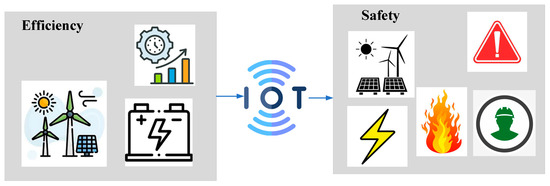
Figure 8.
IoT applications in process automation for operational safety and efficiency.
2.6.1. Smart Metering and Consumption Monitoring
Installed smart meters embedded with IoT devices would allow power utility companies to assess patterns of energy usage, improve the performance of their systems and respond quickly to demand fluctuations. This would allow consumers to make knowledgeable decisions about their energy usage, reduce energy waste, reduce GHG emissions, promote sustainable practices and increase the efficiency of the power system based on the accessibility to information about electrical power consumption. Advanced analytics tools can be used to examine the data gathered by smart metering and consumption monitoring and provide information about the patterns and trends of energy consumption. Power utility companies can use these insights to identify important areas for improvement, such as a reduction in peak demand, the optimization of the battery system and the application of demand response management, which would ultimately enhance the efficiency and sustainability of the energy system. Smart metering can be utilized by consumers to take active control of their energy usage. Smart metering systems can relate to IoT-enabled smart home devices to give a complete picture of energy consumption. The integration of smart metering systems into residential buildings will allow consumers to reduce their energy consumption, reduce monthly or yearly utility bills and live a sustainable lifestyle [24]. A typical diagram for smart metering, consumption and monitoring applications is presented in Figure 9.
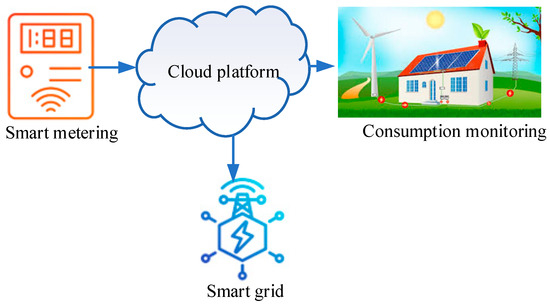
Figure 9.
Smart metering applications for real-time consumption and monitoring.
2.6.2. Predictive Maintenance Using Internet of Things
Predictive maintenance in smart grids utilizes IoT sensors to monitor equipment conditions and leverage historical performance metrics to anticipate equipment failures in wind turbines and solar panels [95]. The approach detects early signs of wear or malfunction of the equipment by allowing quick maintenance that will reduce operational costs, minimize downtime, extend asset life and optimize the overall operational efficiency of installed RESs. Wind turbines, PV systems and other renewable energy infrastructure are constantly exposed to harsh elements. The early signs of equipment failure can be identified by IoT devices based on the analysis of the information obtained from the sensor data and maintenance logbooks of such equipment. The proactive maintenance of the equipment prevents costly breakdowns and ensures the optimal operation of the RES.
- Predictive Maintenance of Solar Panels
The predictive maintenance of PV systems can be carried out by using remote control and automation with IoT sensors to continuously collect data on the health status of solar panels. The technical and meteorological data obtained from the system can be analyzed to forecast the actual time when the PV system is expected to fail or its performance will deteriorate owing to several technical challenges such as corrosion and micro cracks [96]. Predictive maintenance has several advantages in solar systems such as the minimization of unscheduled power interruption, a reduction in repair costs and the consistent energy output of the PV system. The application of IoT devices for the predictive maintenance of solar panels with real-time monitoring is presented in Figure 10. The major components for the predictive maintenance of solar systems using IoT devices include the IoT sensor, IoT gateway, communication network, cloud and edge processing unit, dashboard and monitoring and maintenance and action layer. Sensors are installed on the solar panels to capture real-time operational and environmental data such as irradiance, temperature, voltage, current and soiling from solar panels. The aggregated sensor data is pre-processed by an IoT gateway that ensures secure communication to the cloud/edge. The communication network transmits data obtained from field devices to processing units using Wi-Fi, Zigbee, LoRaWAN, 4G/5G or NB-IoT. AI/ML models are run by a cloud/edge processing unit for the detection of anomalies and the predictive maintenance of solar panels. The dashboard and monitoring unit utilizes Grafana, ThingsBoard, Power BI and Kibana to visualize the health status of solar panels, provide real-time key performance indicators and generate alerts and notifications for operators. The predictive insights of the solar panels are converted into corrective actions such as the repair of major parts, cleaning of panels, replacement of components and scheduling of operation.
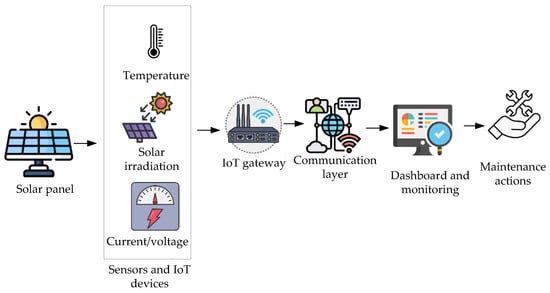
Figure 10.
Application of IoT devices for predictive maintenance of solar panels with real-time monitoring.
- Predictive Maintenance of Wind Farms
Predictive maintenance is crucial for wind farms by using remote control and automation to improve the performance and reduce the downtime of wind turbines. Wind turbines embedded with IoT devices provide detailed data on the condition of each component and allow maintenance teams to detect potential problems before their deterioration [26,28]. The advantages of IoT-driven predictive maintenance include a reduction in downtime and repair costs, safety improvement by preventing catastrophic failures, prolonging the lifetime of wind turbines and the maximization of return on investment. The application of IoT devices for the predictive maintenance of wind turbines with real-time monitoring is presented in Figure 11. Sensors are installed on the major components of wind turbines to capture real-time operational and environmental data such as rotational speed, torque, vibration and power output from wind turbines. The data is sent through communication networks (LoRaWAN, 5G, Zigbee, Wi-Fi and satellite) to gateways. The aggregated wind turbine data is securely filtered and sent to cloud/edge servers. The cloud/edge processing unit is used to store and analyze data using AI/ML models for the detection of abnormal vibration and noise in gearbox/blades, forecasting of component failures, identification of wears in bearing and generators and predictive maintenance. The real-time predictive maintenance of wind turbines is visualized using dashboard solutions to display turbine health status, blade stress, performance and vibration trends, predicted faults and overall power production. Alerts or notifications are sent to operators through SMS, email or mobile apps using the dashboard and real-time visualization unit. The maintenance teams are dispatched to the wind farm to carry out preventive measures such as blade inspection, gearbox lubrication or generator cooling before breakdowns of wind turbines. The predictive maintenance of wind farm reduces downtime and associated costs.
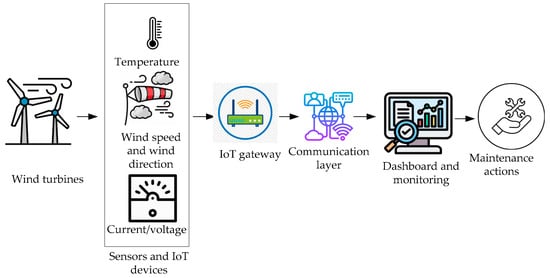
Figure 11.
Application of IoT devices for predictive maintenance of wind farms with real-time monitoring.
2.7. Smart Grids
A smart grid is a system that utilizes digital technology and two-way communication facilities to enhance the reliability, efficiency and sustainability of a power supply at the load points. It utilizes various technologies like an advanced metering infrastructure, sensors and automated controls, communication networks, energy storage systems, distributed energy resources and grid management systems to coordinate and manage the flow of electrical power from different generation sources to consumption points. It allows the real-time monitoring of power supply and load demand, the optimization of energy usage and the integration of RESs into the conventional power system. The conventional power systems of some countries have been upgraded to emerging power systems with the integration of smart features as a measure to satisfy the requirements of the sustainability, privacy, security and reliability of the networks. The performance of smart grids has surpassed the capabilities of traditional power systems by offering a range of advantages such as improved efficiency, resilience and reliability, guaranteed energy security, improved resilience and adaptability, enhanced user participation, advanced sustainable development and cost saving [97]. A smart grid is an innovative technology that utilizes communication and information facilities to achieve the optimal management, real-time monitoring and intelligent scheduling of the power system using sensors, information and computer technology, smart features and communication networks. The ability of the smart grid to monitor and control the grid and achieve the optimal management of the utility grid and reduction in unscheduled power interruptions is based on the utilization of smart features and emerging technologies in the existing power systems. The key components of a smart grid are presented in Figure 12.
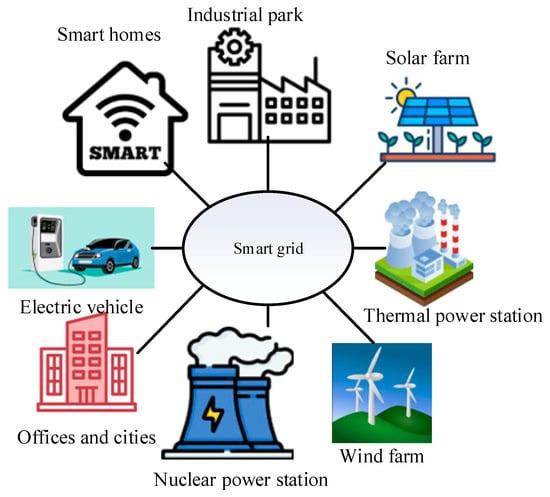
Figure 12.
Key components of a smart grid system.
Comparison of Traditional Power Systems and Smart Grids
The solutions presented by the smart grid can be used to overcome the challenges of aging infrastructure, a lack of real-time monitoring, limited customer engagement, vulnerability to blackouts, limited flexibility, high transmission losses, a lack of access to power supply and poor scalability [98]. A complete implementation of the smart grid would support the economic feasibility of RESs in the utility grid to satisfy ever-increasing load demands. The technology would also allow consumers to actively participate in the real-time monitoring of their energy usage, electricity bills and the deployment of electric vehicles from the grids. The failure of traditional power systems to address the problems of a consistent power supply has been attributed to numerous technical issues. These challenges can be addressed by the conversion of traditional power systems to smart grid systems. The comparison between a conventional power system and smart grid is presented in Table 5 [24,99].

Table 5.
Comparison of characteristics of smart grids and traditional power systems.
2.8. Distributed Energy Resources
Distributed energy resources are small-scale energy generation and electric storage systems that are located at or near the point of use, rather than centralized power systems. The integration of DERs such as wind turbines, microturbines, battery systems, PV systems and fuel cells into the traditional power system has considerably transformed the system into a reliable, resilient and efficient power system by reducing the reliance on fossil fuels and improving grid stability [16]. DERs are classified based on energy sources and the operational mode and functionality are presented in Table 6 [100,101,102].

Table 6.
Classification of distributed energy resources based on energy sources, mode of operation and functionality.
Challenges of Distributed Energy Resources
DERs are decentralized small-scale energy technologies that offer significant benefits like increased energy independence, reduced carbon emissions and enhanced grid resilience but their integration into an existing power system which is originally designed for a centralized energy system poses several critical challenges [17]. The decentralized nature of DERs introduces several technical, operational, economic and regulatory challenges such as grid integration complexity, a lack of standardization, cyber security risks, regulatory and policy barriers, limited visibility and control for utilities, complex ownership and responsibility, load forecasting and planning difficulties, power quality issues and communication infrastructure requirements to the power systems. The adoption of DERs has been globally acknowledged as an exciting opportunity to meet an ever-increasing load demand but comes with several challenges that can be overcome by using the right approaches, such as smart grid technologies, innovative market designs, adaptive regulatory frameworks and continued technological advancements in areas like energy storage and IoT-driven control systems. Policymakers must work in conjunction with the power utility companies to formulate different policies that can be used to surmount the existing challenges and harness the potential of DERs [103]. It is paramount that microgrid operators heavily invest in DERs as a strategic measure to achieve a sustainable and efficient energy system. The transition to DER solutions is beneficial to commercial interests but also strengthens the overall energy infrastructure.
2.9. Integration of Smart Grids into Distributed Energy Resources
Smart grids and DERs are major components for the transition of a traditional energy system to an emerging energy system [30]. The integration of DERs such as battery storage systems, PV systems, microturbines, pump storage systems and wind turbines into smart grid systems can improve the energy efficiency, sustainability, resilience and reliability of the power system. The application of smart grid features to coordinate distributed energy resources and associated components are presented in Figure 13. The advanced communication and control abilities of smart grid systems are vital for managing the output power of DERs and maintaining a continuous power supply at consumer centers. This integration also supports the active participation of consumers in energy management and promotes a responsive and dynamic transactive energy system. Smart grids integrate DERs like solar panels, storage systems and wind turbines and cutting-edge technologies to monitor and control the flow of electricity in the power systems [17]. The integration of DERs into smart grids has several benefits such as improved energy efficiency, cost savings, sustainability through renewable energy adoption, improved grid reliability during outages and revenue opportunities [26]. The convergence of smart grid features and DERs in a single power system can be used to overcome the challenges of using DERs alone in a grid-connected or standalone hybrid energy system. The convergence of smart grid features and DERs in a single power system also facilitates the modernization of electricity infrastructure, supports the seamless integration of renewable energy resources and improves the efficiency and security of the power system [19]. It also allows the effective management of the stochastic nature of local RESs and supports the bi-directional flow of energy. The improved grid management systems based on the introduction of smart technologies into the traditional power system allow the utility grid operators to have greater control of their networks and allow the effective voltage control and load balance of the entire network. The rapid change in power demands at the load points requires careful planning to manage the complex collaborations between multiple DERs and the smart grids effectively [104]. Power utility companies can harness the potential of DERs by applying smart grid technologies in a sustainable energy system while addressing the challenges posed by emerging grid dynamics.
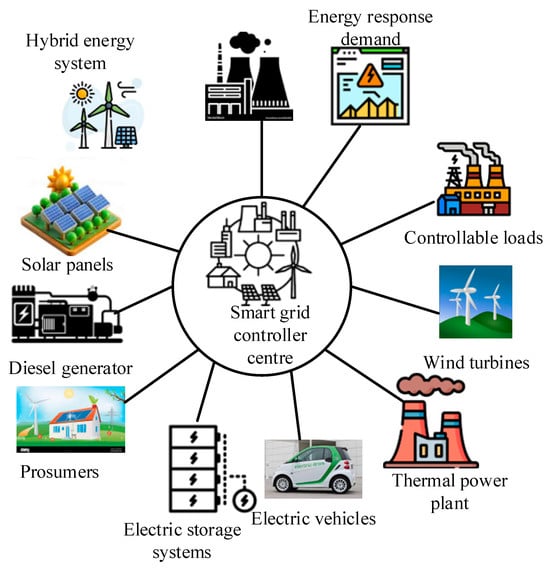
Figure 13.
Coordination of distributed energy resources with smart grid features.
2.10. Management of Distributed Renewable Energy Sources and IoT Within a Smart Grid
Smart grid management is a dynamic field that entails the application of cutting-edge technologies to improve the efficiency and sustainability of conventional power systems [105]. The integration of intermittent RESs into the utility grid requires intelligent management systems that can be used to monitor and analyze energy flows in real time, forecast power interruptions, automatically adjust the components of the power system to maintain grid stability and optimize energy consumption. This has resulted in resilient and flexible utility grids that can handle a growing proportion of RESs. The management and control of DERs within a smart grid system encompasses the integration of IoT devices to optimize energy generation and energy usage [106]. IoT devices are used in RESs to optimize energy distribution and management by collecting real-time data from energy production and grid conditions [16,24]. The data obtained from sensors and devices installed on the power system can be analyzed to predict and mitigate the adverse effects of power supply fluctuations, grid imbalances and voltage variations in the power systems [26]. IoT devices are also integrated into RESs to facilitate the seamless operation of the smart grid using sensors, actuators and smart devices to address intermittent challenges and enhance the stability of the power system [27]. The collaboration between RESs, smart grids and IoT can be used to accomplish a clean and resilient energy system. The benefits of a smart grid system embedded with IoT include predictive maintenance, real-time monitoring and control, scalability and flexibility, cost savings, consumer empowerment, balanced energy generation with consumer demand and enhanced grid stability and a reduced risk of blackouts [21]. A typical smart grid management system from generation sources to varying electricity demand at the load points is presented in Figure 14.
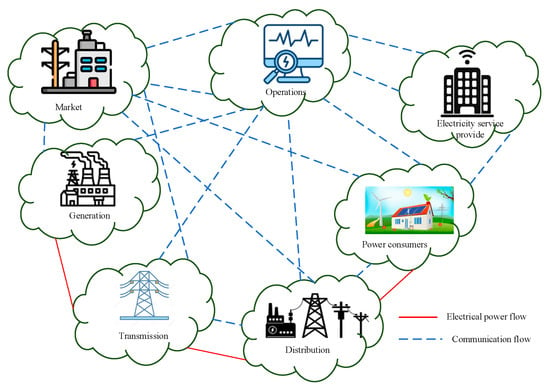
Figure 14.
A typical diagram of smart grid management system from generation sources to varying electricity demand.
2.11. Application of IoT in Monitoring Photovoltaic Systems Within Smart Grids
A smart grid system embedded with IoT devices plays a proactive role in monitoring PV panels by collecting real-time data, allowing remote monitoring and facilitating predictive maintenance. This has led to a significant reduction in downtime, cost reduction, an improvement of the system performance and the optimization of solar system energy management [107]. It also enhances the efficiency and cost-effectiveness of smart grid systems in managing and utilizing the energy obtained from the PV system. Power utility companies and system operators can significantly increase reliability, reduce maintenance costs and optimize power flows by using IoT for PV system monitoring within a smart grid system. The integration of cutting-edge tools into renewable energy systems is a proactive approach to managing the system. The principal applications of IoT in the PV systems include performance monitoring and optimization, fault detection and diagnostics and remote control and management. IoT devices with several sensors are installed on the solar panels to gather operational data that can be utilized to monitor the performance of the PV system [33]. The data is transmitted to the cloud platforms where analysis and visualization will be carried out. The integration of IoT for the real-time monitoring of a PV system in a smart grid is presented in Figure 15.
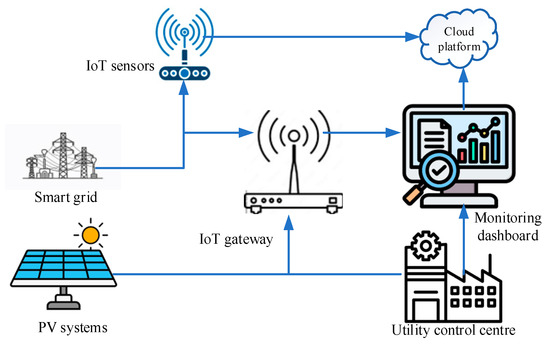
Figure 15.
Integration of IoT for real-time monitoring of a PV system in a smart grid.
2.12. A Smart Grid IoT-Enabled Wind Turbine Monitoring System
IoT plays a significant role in improving the efficiency, reliability and intelligence of wind turbines with the integration of smart grid features [32]. IoT can be used in smart grids for fault detection, real-time monitoring and the optimization of wind turbines to support the dynamic energy demands of the utility grid [19,24]. A smart grid IoT-enabled wind turbine monitoring system is a sophisticated solution that integrates cutting-edge technology to achieve maximum efficiency and the smooth integration of wind energy into emerging power systems. The main features of the integration include performance monitoring and optimization, fault detection and diagnostics and the remote control and management of wind turbines. The integration of IoT for the real-time monitoring of wind turbines in a smart grid is presented in Figure 16. The power output of the wind turbines can be transformed into highly efficient and resilient components of the future energy system by the proactive actualization of the functionalities of the integration. This integrated approach transforms wind energy management from a reactive process to a proactive, data-driven and highly efficient system within the context of a modern smart grid [26]. The benefits of the integration also encompass reduced on-site visits, faster response to issues, improved operational flexibility, improved security, increased energy generation by adapting to wind changes, identified inefficient turbines for servicing and reduced energy loss and wear on components.
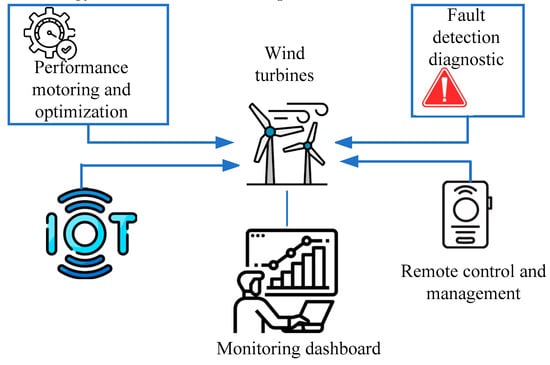
Figure 16.
Integration of IoT for real-time monitoring of wind turbines in a smart grid.
2.13. IoT-Enabled Demand-Side Management and Integration with Smart Homes
Demand-side management (DSM) is a strategy that can be used to control and reduce electricity consumption on the consumer’s side of the meter. A typical diagram of smart home energy with IoT-based DSM is presented in Figure 17. The objective of DSM is to optimize the utilization of energy, reduce peak energy demand, support dynamic energy pricing and improve the stability of the power system. Demand response systems powered by IoT allow grid operators to adjust energy consumption by using real-time data [108]. This can be utilized to reduce power consumption during peak periods, reduce the use of fossil fuels-based generating units as backup units, improve grid reliability, reduce energy wastage and optimize the utilization of energy resources. The IoT-enabled DSM is utilized in smart homes to allow optimum energy consumption by integrating smart devices to manage and control energy usage, increasing grid stability and promoting the sustainability of the energy system. IoT-enabled DSM is used in smart homes for the real-time monitoring of energy consumption, the integration of DERs, and the automatic control of smart homes and the adapted energy management system. Smart homes have become active participants in the energy markets with the advent of intelligent devices, smart meters and sophisticated energy management systems [109]. This has led to a significant transformation of conventional power systems that depend on a unidirectional power supply and demand. The seamless communication between residential appliances and the utility grid through IoT and DSM has converted most homeowners to prosumers. The vested interest of consumers in actively participating in energy generation activities has considerably reduced the cost of energy and utility bills and significantly contributes to a reliable and sustainable power supply at the load points.
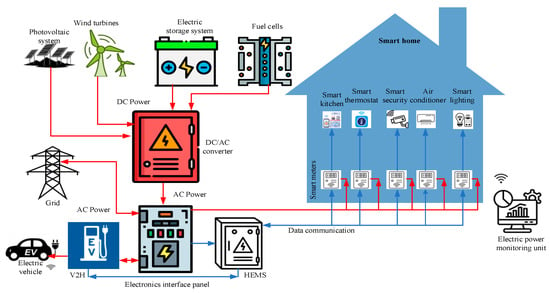
Figure 17.
A typical diagram of smart homes energy using IoT-based DSM.
3. Artificial Intelligence
Artificial intelligence is a set of technologies that allow computers to implement tasks typically associated with human intelligence such as data analysis, the translation of languages, learning, decision-making and problem solving [29,91]. The informed decisions of AI are very fast and accurate by offering insights beyond human capabilities; this shows that outcomes of AI can be used in various sectors of the economy. AI is a computational system that primarily utilizes deep learning (DL) and machine learning for data analytics, predictions and forecasting and intelligent data retrieval. Applications of AI have been globally acknowledged in various industries in profound ways such as healthcare services, finance, retail and e-commerce, manufacturing, transportation and logistics, cyber security, agriculture and education. The benefits of AI technologies from the perspectives of society and the economy include zero risks, complex global challenges, enhanced cyber security, time saving capability, climate change mitigation, improved process efficiency, reduction in human errors, unbiased decisions and fostering innovation [110].
3.1. Artificial Intelligence Tools and Techniques
The foundation of AI was based on various learning theories such as statistical learning, evolutionary learning and neural learning. Neural networks and SVMs are the most popular learning algorithms utilized in the literature. In addition, AI algorithms consist of Random Forests, Decision Trees, Logistic Regressions, Linear Regression, Nearest Neighbor, Naïve Bayes and Hidden Markov. Renewable energy systems have adopted smarter systems like AI to make them more resilient and responsive [90]. The classification of AI techniques based on ML methods, metaheuristic algorithms and other techniques is shown in Figure 18.
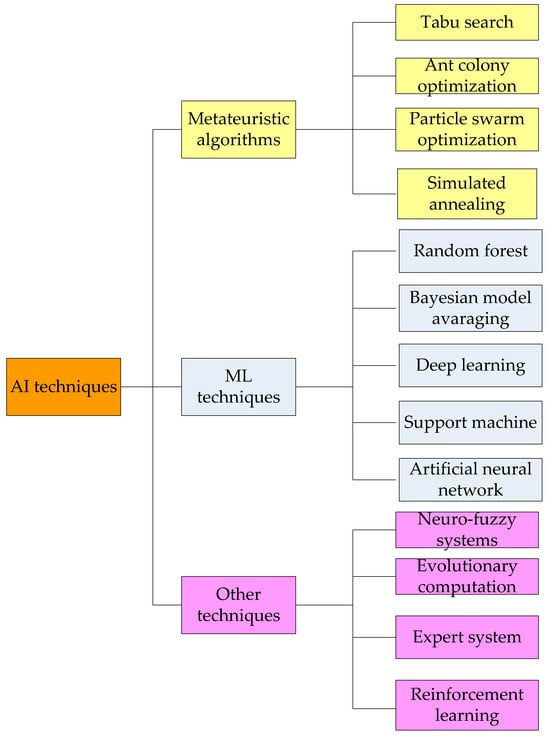
Figure 18.
Overview of artificial intelligence techniques and their classification.
3.1.1. Metaheuristic Algorithms
Metaheuristic algorithms are high-level problem-solving strategies that can be used to find optimal solutions to complex optimization problems when mathematical approaches are practically not feasible, owing to computational complexity, large search spaces and nonlinearity. They are globally utilized in energy systems, power engineering, industrial and manufacturing systems, logistics, healthcare, bioinformatics and economics to find optimal solutions to complex and large-scale problems. Metaheuristic algorithms are classified into different categories based on the inspiration source, problem nature, search strategy, operational characteristics, exploration and hybridization approaches. A comparison of metaheuristic algorithms based on their strengths, weakness and applications are presented in Table 7 [111,112,113,114,115,116].

Table 7.
Overview and comparison of metaheuristic optimization techniques.
3.1.2. Machine Learning
Machine learning is a branch of AI that allows a system to automatically learn patterns from data and improve the performance of a particular task without being explicitly programmed. It is a statistical technique that can be used to establish computational models and make predictions based on the previous or stored data. The key characteristics of machine leaning methods are that they are data driven, adaptive, have a predictive capability and are capable of generalization. ML is one of the most versatile AI techniques that can be used in different applications such as computer science, energy systems, manufacturing, logistics, healthcare, agriculture, education, smart grids, business and finance. DL is a subset of ML that uses artificial neural networks with multiple layers to automatically learn complex patterns and representations from large amounts of data and make accurate predictions. DL models can extract features and make predictions directly from raw data inputs. A comparison of ML and DL techniques based on some key features is presented in Table 8 [117,118,119,120].

Table 8.
Comparison of machine learning and deep learning techniques based on their characteristics.
3.2. Artificial Intelligence in Renewable Energy Systems
Artificial intelligence has become a transformative force in RESs with numerous applications such as energy forecasting, resource assessment, smart grid management, energy trading, demand response management system, smart homes and predictive maintenance [21]. The integration of AI features into RESs can be used to improve efficiency, reduce the challenges of grid integration, reduce electricity bills and enhance predictive maintenance [90]. AI can be utilized to analyze the data obtained from DERs such as wind turbines, PV systems and electric storage systems to identify energy patterns that are very difficult for human beings to detect. This would assist the renewable energy-based distribution network operators in optimizing the performance of their networks and improve the efficiency and sustainability of the energy system [26]. AI has played a significant role in grid management, the improvement of energy generation forecasting and the sustainability of PV systems and wind turbines by reducing unscheduled downtime by 20–40% and 35–50% [121,122]. AI is also utilized in renewable energy projects to reduce the operational costs of decentralized energy systems by the early detection of signs of wear and failure through predictive maintenance; this increases the lifetime of the infrastructure. The efficiency of solar energy has been increased by 15–67.65% owing to the optimization of PV panel orientations and the tracking of solar irradiance [123]. The potential of solar energy can be harnessed by AI to improve energy forecasting, enhance grid stability and increase the efficiency of the power system. AI can be utilized in the power system to forecast energy generation from renewable energy resources and allow grid operators to balance power supply and load demand. AI contributes to the overall cost reduction in RESs by improving efficiency and reducing maintenance costs [24]. The role and functions of AI in improving the efficiency of DERs are presented in Figure 19.
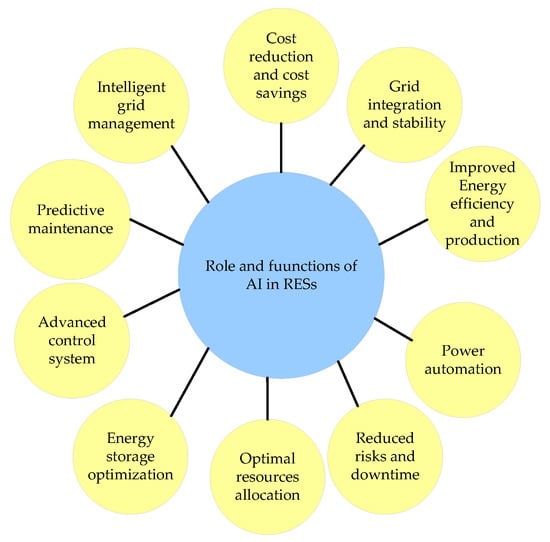
Figure 19.
Role of AI in improving the efficiency of renewable energy technologies.
3.3. Forecasting and Prediction of Renewable Energy Using Artificial Intelligence
Renewable energy forecasting is the process of predicting electrical power that emanates from renewable energy sources. Accurate forecasting is one of the crucial factors that can be utilized to balance load demand and power supply in the utility grid by carrying out predictive maintenance and strategizing the optimization of the energy market. AI algorithms predict wind and solar power output by allowing grid operators to optimize energy storage and dispatch other energy sources [97]. AI algorithms can process massive amounts of data and recognize complex trends that traditional algorithms could have disregarded [124,125]. The vast amount of weather data, historical generation trends, grid conditions and real-time situations can be trained by AI models for the prediction of renewable energy output. This allows utility companies to optimize energy storage, dispatch other sources and guarantee a smooth and continuous power supply at the respective consumer centers. AI models can be used to enhance the accuracy of energy forecasting and resource assessment based on the proper planning, coordination and management of RESs. The forecasting and prediction of energy using AI has been globally accepted as a crucial area that can be utilized to enhance the accuracy of predicting energy generation from RESs like solar, wind and bioenergy [27,126]. The effective management of utility and the integration of RESs into conventional power systems with accurate projections are vital for energy trading, grid management, efficient resource allocation and the optimal operation of electric storage systems.
3.4. Energy Generation Forecasting Using Artificial Intelligence
The integration of AI has transformed energy generation forecasting by providing accurate and real-time predictions that are crucial for grid stability, cost reduction, the improvement of efficiency and the successful integration of RESs in the power system [28]. Energy producers or prosumers and grid operators of modern power systems can analyze real-time and historical generation data to forecast their energy. This data encompasses a wide range of variables such as historical weather patterns, energy consumption habits, grid load information and economic indicators. AI models can be used to track the daily positions of PV panels in order to optimize solar irradiance obtained from the sun. AI models are used to track the location of the solar irradiance and weather conditions to ensure that PV panels are positioned correctly for maximum energy harvest. This improves solar energy conversion efficiency, enhances accuracy and reduces the effects of the intermittency of solar irradiance. AI models that consist of deep learning and machine learning can be used to predict solar irradiance by analyzing historical data and detecting the intricate patterns. The breakdown of the models is based on data collection and preparation, model selection and training and prediction and evaluation [127]. Historical data on solar irradiance, temperature, humidity, cloud cover and other relevant factors are utilized to train AI models [128]. The performance of the model can be improved by cleaning, pre-processing and normalizing the raw data. Models are trained in the prepared data to learn the relationships between input features and solar irradiance. After training, the models can forecast future solar irradiance using new input data. The performance of the system can be evaluated by utilizing some key performance parameters such as the coefficient of determination, root mean square error and mean absolute error. A typical diagram of energy generation forecasting with AI is presented in Figure 20.
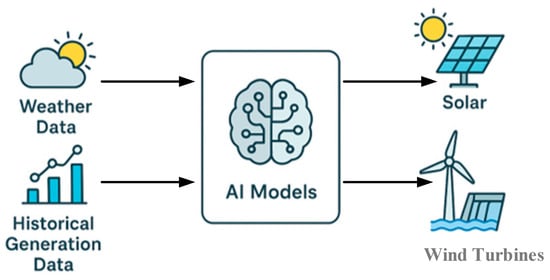
Figure 20.
A typical framework for energy generation forecasting using artificial intelligence.
3.5. Load Demand Forecasting Using Artificial Intelligence
AI algorithms based on the analysis of historical energy consumption data, weather forecasts and other important factors permit power utility companies to implement demand response strategies by adjusting energy generation and load demand to match fluctuations in renewable energy availability. Load demand forecasting is a significant component of an emerging power system that allows utilities to balance demand and supply, optimize grid operations and enhance overall system reliability. Load demand forecasting can be used to predict energy consumption over a duration of time. The accurate forecasting of intermittent RESs is needed for balancing power supply and load demand. AI-based load demand forecasting combines historical data, meteorological inputs and renewable generation profiles using ML and DL models to create accurate net load forecasts. AI can be used in load demand forecasting to predict electricity consumption patterns based on the optimal utilization of RESs and fossil fuels. AI models can accurately predict energy demand and allow the grid operators to balance power supply and load demand during the peak periods by analyzing historical data, weather patterns and consumption trends [34,129]. This reduces the need to activate fossil fuel-based power stations when RESs are available or predicted to be available. AI-powered forecasting utilizes ML models to analyze a large amount of data such as historical consumption patterns, weather forecasts and social media trends to predict future energy demand [32]. The grid operators can optimize the dispatch of RESs by accurately predicting demand. AI models are used in power forecasting to contribute to stability and reliability utility grids. This is achieved by forecasting the anticipated peak usage times and ensuring that sufficient power is available to meet the load demand. Load demand forecasting with AI can be used to prevent unscheduled power interruptions and ensure a continuous power supply. A schematic diagram that illustrates the application of AI technique for predicting load demand is presented in Figure 21.
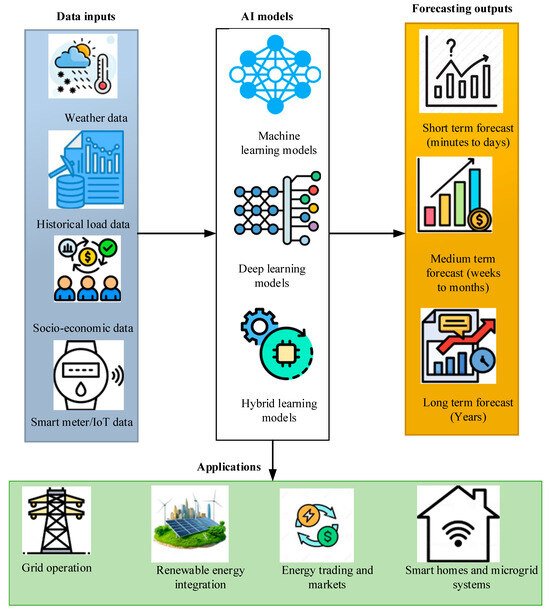
Figure 21.
A schematic diagram that illustrates the application of AI technique for predicting load demand.
3.6. Resource Management Using Artificial Intelligence Algorithms
Resource management is the process of monitoring and optimizing the performance of energy systems [130]. AI-powered resource management in hybrid renewable energy systems can be used for forecasting, battery systems optimization, load balancing, smart grid integration, cost minimization, dynamic optimization and optimal sizing. The seamless operation of renewable resources to deliver consistent power at the load points is not always possible owing to their unpredictable nature. This has led to the exigency of RESs to back up the power requirements of the utility grid. AI can support continuous switching between renewable and traditional energy resources to ensure a consistent power supply. The data obtained from components of the power system can be used to ensure the effective deployment of energy and distribution. The embedded operation of AI, smart grid features, RESs, battery systems and demand response can be used for the dynamic balancing of the power supply and load energy. The electrical demands of consumers can be satisfied by using digital-based communication facilities to monitor and control the dispersal of electrical power from different sources to the load points. This integration leads to a balance of the load demand and electricity obtained from the utility grid, a reduction in energy waste and the maximum utilization of RESs. AI can significantly increase the performance of the power system by providing automated control mechanisms, predictive insights and real-time data analysis [131]. It can make decisions in real time to maximize the efficiency of the power system by using data obtained from different sources such as generating units, battery systems and energy demands. The real-time decisions cover battery system management, demand response and load balancing. A typical diagram of smart grid and AI control schemes for monitoring and optimizing the performance of energy systems is presented in Figure 22.
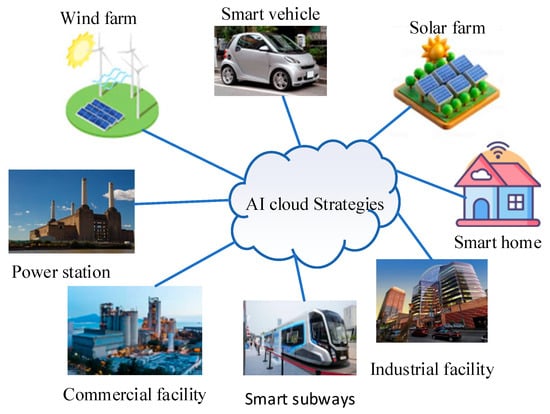
Figure 22.
Smart grid using artificial intelligence control schemes.
3.7. Grid Optimization Using Artificial Intelligence in Grids with High Renewable Penetration
The integration of AI algorithms into grids has transformed grid operations and improved the efficiency and resilience of the power system [28]. The penetration of RESs into utility grids has significantly improved in recent times with the integration of AI algorithms in the utility grids. AI-powered grid optimization is significant for the effective implementation of high levels of renewable energy in utility grids by using intelligent power routing, congestion management and voltage stability. AI models can be used in smart grids to optimize energy consumption by predicting demand patterns and managing load demand. The utility grid operators can predict and manage the variability of RESs and optimize energy flow by AI techniques to improve the efficiency and integration of RESs into the power system [16,24]. Intelligent power routing is achieved by AI-powered grid optimization by evaluating grid conditions based on load demand and energy supply as well as the optimization of power flow within the system to reduce power losses and ensure a continuous power supply. The congestion management of AI-powered grid optimization can be achieved by maintaining grid stability during periods of high generation from RESs. This can be accomplished by predicting potential congestion points and dynamically adjusting power flow [132]. AI algorithms can be used to prevent equipment damage, maintain a reliable power supply and optimize voltage profiles by ensuring that voltage levels operate within acceptable limits. Grid optimization using AI in utility grids with high renewable penetration is a major research and practical area in modern power systems. A comparison of the power system with high penetration of renewable energy systems before and after the integration of AI is presented in Table 9 [124,133,134,135,136,137].

Table 9.
Comparison of operational performance of the power system before and after AI integration into RESs.
3.8. Predictive Maintenance and Fault Detection Using Artificial Intelligence
AI has become a transformative energy tool that can be used for effective the fault detection and predictive maintenance of a power system [14]. Fault detection is the process of identifying when the power system deviates from its typical operating conditions and equipment diagnosis can be used to identify the underlying source of the defects. Equipment diagnosis and fault detection are utilized in a power system to ensure that electrical problems are detected on time and properly identified to prevent severe damage and protracted downtime. Artificial intelligence can enhance problem detection and diagnosis through the real-time analysis of data, pattern recognition and fault prediction before they occur. ML models can be trained on past fault data to identify the signatures of various kinds of faults by allowing faster and more precise detection [97]. AI models can analyze data obtained from sensors and other sources to predict equipment failures, optimize maintenance schedules and reduce downtime [16,34,138]. This improves the efficiency of the power system, increases cost savings and reduces operational costs [139]. AI can be used in the power system for fault detection and diagnosis by identifying the causes of faults, improving the speed and accuracy of repairs and minimizing downtime [75].
3.8.1. Predictive Maintenance Using Artificial Intelligence
AI-driven predictive maintenance has gained prominence as a transformative method to increase the performance of power systems [140]. Predictive maintenance models based on AI models utilize sensor data and historical performance metrics to anticipate component failures in wind turbines and PV systems [26]. The predictive maintenance approach can be utilized to reduce maintenance costs, optimize the overall operational efficiency of renewable energy installations, increase the lifetime of the systems and prevent unanticipated downtime of the equipment by allowing the operators of the power systems to carry out maintenance tasks only when necessary. AI algorithms are used to analyze historical data obtained from the sensors and find trends that predate equipment failures. ML models can accurately forecast future failures by allowing for prompt responses. Predictive maintenance can be used in the power system for the early detection of malfunctioned or worn-out components, minimize downtime, prolong the lifetime of equipment and reduce operational costs [141].
3.8.2. Predictive Maintenance for Solar Panels Using Artificial Intelligence
The challenges that operators of solar farms are facing currently such as unscheduled breakdowns, equipment inefficiencies and the need to maintain a continuous power output can be overcome by using the analytical tools of AI [142]. The predictive maintenance offered by AI analytics can be used to collect large amounts of data from sensors embedded in PV panels. The sensors provide real-time data about the health status of the PV panels by monitoring the operating and technical parameters of the power system such as load demand, solar irradiance and ambient temperature. AI models can analyze the data to detect trends and abnormalities that show imminent failures [29,143]. Having analyzed the data, the system can predict when the PV panel is expected to fail due to micro cracks, corrosion, etc. The analyzed data obtained from the sensors can be used by AI to detect problems, optimize performance, reduce downtime, minimize unscheduled power interruption, reduce costs, improve uninterrupted energy production and guarantee a consistent energy output [144].
3.8.3. Predictive Maintenance for Wind Farms
Predictive maintenance is crucial for wind farms, using remote control and automation to provide detailed data on the condition of each component of the wind turbine and allowing maintenance teams to detect impending issues before they escalate [145]. AI models are used in the predictive maintenance of wind turbines to reduce downtime and repair costs, improve the safety of the equipment, prevent catastrophic failures, increase the lifetime of wind turbines and maximize the return on investment. AI models are used in the predictive maintenance of wind turbines to analyze historical records and sensor data to predict the potential failures of the equipment before they occur [143]. The early detection of electrical problems can prevent costly emergency maintenance, prolong the lifetime of critical components and ensure that wind turbines operate at peak performance to increase the reliability of the power system. The benefits of AI in the predictive maintenance of wind turbines can be fully harnessed by scheduling the maintenance activities during off-peak periods as a measure to ensure uninterrupted power production.
3.8.4. AI Model Validation Methods and Performance Metrics
AI model validation methods and performance metrics are used in renewable energy applications for forecasting, scheduling, fault detection and optimization. Validation methods are utilized in the power system to ensure that AI models in renewable energy systems such as PV, wind, fuel cells, small hydro and hybrid energy systems are not over fitted [146]. Model validation is the process of testing an AI/ML model and making reliable predictions on new data. A comparison of different types of AI validation methods based on the description, advantages and limitations is presented in Table 10 [146,147,148]. Performance metrics are numerical measurements that are used to assess a model’s predictive performance [149]. They can be used by researchers to determine whether a model is appropriate for practical applications by offering information on the model’s accuracy. They can be utilized for model comparison and identify whether a model is over fitting or under fitting. The performance metrics of the problem based on regression are presented in Table 11 [150,151,152].

Table 10.
Overview of AI model validation methods.

Table 11.
Comparison of the main regression performance metrics.
3.9. Markets and Trading Using Artificial Intelligence
Transactive energy is a decentralized energy market where prosumers dynamically buy, sell and trade energy in real time by using smart contracts or automated pricing. AI tools are intelligent features that can be utilized by the stakeholders of the energy market for the transformation of the TE system, the automation of energy trading, decision-making and price optimization in decentralized energy markets [153]. Conventional power systems are passing through a significant transformation based on technological breakthroughs and the urgent need to switch to sustainable energy systems. The use of AI in energy trading and markets is among the most fascinating advancements in the TE system that has considerably changed the energy market by improving the efficiency of the power system, optimizing pricing and facilitating precise market forecasting. Energy trading is the process of purchasing and selling electrical energy generated from renewable sources in energy markets [97]. Energy trading can be enhanced by using AI to predict the cost of energy and power output and allows producers to make the best market decisions [32]. The cost of electricity can be forecasted by AI models with high accuracy by analyzing databases that include historical market data, weather forecasts and grid condition data. The AI-enabled energy market allows producers to maximize their revenues and minimize market deviations by reducing the probability of incurring fines for failing to satisfy contracted energy demands [154].
4. Synergy and Integration of IoT and AI in Renewable Energy Systems
The convergence of AI, IoT devices and smart grids can create highly autonomous, efficient and resilient power systems by using secure control systems, real-time data and predictive analytics to reduce the cost of energy at generation and consumer standpoints. A typical diagram that shows the integration of IoT and AI in RESs is presented in Figure 23. The synergy between these technologies has transformed traditional power systems into smart and self-regulating systems and improves the autonomy of the power system. The transformation of conventional power systems to sustainable and efficient power systems is being fueled by the integration of IoT and AI in RESs. These technologies can be used to fully harness the potential of RESs while simultaneously opening the door to a cleaner and more resilient energy system by allowing predictive maintenance, real-time monitoring and optimized grid management. The convergence of IoT and AI has transformed the power system by unlocking TE systems and smart energy systems that are responsive and autonomous in nature. AI algorithms are utilized in decentralized energy systems to facilitate peer-to-peer (P2P) energy trading and optimize the energy flow within microgrid systems. AI can also be used in the smart grid to balance the energy supply from solar and wind farms with real-time demand to guarantee a continuous power supply [155]. The convergence of IoT and AI in RESs can be utilized to increase the monitoring and control capability of various parameters of the power system. IoT sensors are embedded into RESs to collect data in real time through the internet or other connected networks [156]. IoT devices are integrated into the power system to collect real-time data from performance metrics, equipment health status, environmental conditions, energy storage, grid infrastructure and consumption points. This data is wirelessly transmitted to a centralized system using communication protocols that ensure that the data is transmitted reliably through communication networks to centralized platforms or edge computing devices. Once the data is collected by AI, the data is analyzed for streamlined predictions, the detection of issues and optimized operations of the power system.
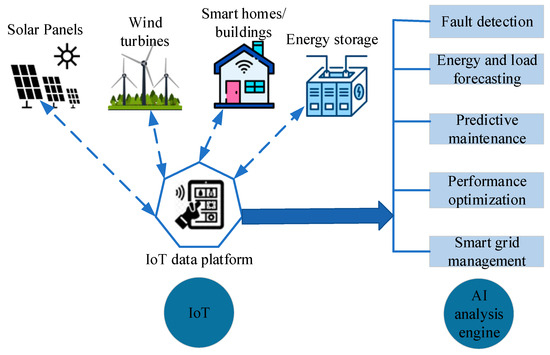
Figure 23.
A typical diagram of integration of IoT and AI for management and control of RESs.
4.1. Dashboard Solutions for IoT and AI in Renewable Energy Systems
Dashboard solutions are reporting mechanisms that visualize the key performance indicators and metrics of the power system on a screen and improve data analysis and educated choices of different organization [137]. They are information management systems that convert complicated data from multiple databases into thorough visual representations like tables, charts and graphs by offering useful insights into power system operations, patterns and possible problems. Dashboard solutions have become essential tools for the monitoring of real-time energy consumption, energy cost analysis, the optimization of GHG emissions, peak demand analysis, equipment performance monitoring, the integration of weather data, predictions of energy cost, renewable energy integration, energy savings measurement, energy conservation measures tracking, alarm and notification systems, mobile accessibility, the cost–benefit analysis of renewable energy projects, energy usage breakdown, predictive maintenance and energy procurement and supplier analysis. They are interactive tools that allow the combination of real-time data from different sources and provide AI-assisted data preparation, chart creation and data analysis and analyze and display key performance indicators. Dashboard solutions are visual interfaces that integrate IoT and AI technologies in renewable energy systems and provide the real-time monitoring of PV systems, wind turbines, battery systems and grid performance; the optimization of operation and maintenance cost and energy flows; forecasting and scheduling for the prediction of demand, weather and renewable generation; and decision support to operators, consumers and policymakers with clear performance indicators such as cost savings, GHG reduction and reliability [157]. Dashboards act as a bridge between the raw data collected by IoT devices and AI models [158].
The classification of dashboard solutions for IoT and AI in renewable energy systems based on commercial, open-source and specialized solutions is presented in Figure 24. Industrial dashboards are commercial platforms designed by energy solution development companies to maximize revenue and manage the flow of power, renewable energy systems, industrial applications and smart grid systems. The features of industrial dashboards encompass highly robust and secured power systems with advanced predictive maintenance, real-time monitoring and integration with industrial IoT [159]. The operations of industrial dashboards in the power sector are limited owing to their high cost and limited flexibility and because they are not suitable for small- to large-scale applications. Open-source dashboards are free-to-use platforms that allow researchers and developers to build customizable monitoring and optimization systems for renewable energy and IoT applications [160]. The features of open-source dashboards include flexibility, reduced costs and being specially integrated with AI algorithms and IoT devices. They require technical professionals, limited in-built AI models and high security concerns. Specialized dashboards are application-specific dashboards designed for particular renewable energy use-cases such as microgrid systems, EV charging systems and hybrid energy storage management. The features of specialized dashboards include advanced control algorithms, storage scheduling, EV charging and demand–response for the optimal operation of the power system. The operations of specialized dashboards are limited due to the narrow focus and limited adaptability outside their intended application domain. A comparison of dashboards based on their applications, features, limitations and AI integration is presented in Table 12 [158,161,162,163,164,165].
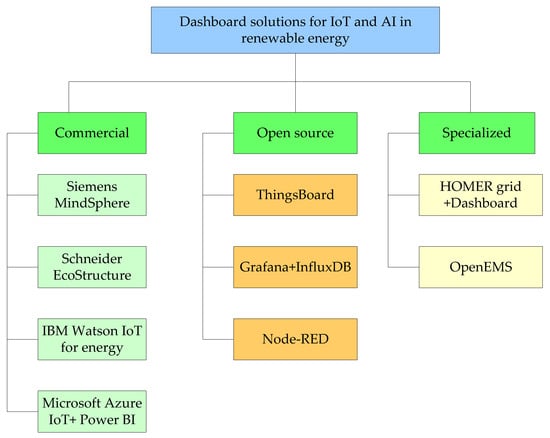
Figure 24.
Classification of dashboard solutions for IoT and AI in renewable energy systems.

Table 12.
Comparison of IoT and AI dashboard solutions in renewable energy systems.
4.2. Overview of Software Tools That Support AI and IoT Applications in Renewable Energy Systems
The application of software in a power system is one of the significant patterns in global development that balances the financial prosperity of RESs with environmental protection [166]. Software is used to improve the performance of wind turbines and solar panels, optimize the layouts of solar and wind farms, determine the optimal placement of PV and wind turbines in the distribution power system and optimize energy storage solutions [167]. Renewable energy software utilizes IoT, AI and other technologies to collect, transmit, process, analyze and manage data. The integration of AI and IoT software can be used to improve the efficiency and sustainability of the power system. The benefits of RESs can be harnessed with the full implementation of AI and IoT software in the power system. AI and IoT software can be used for the optimization of a renewable energy system by improving grid management and forecasting energy generation and the efficiency of the power system [168]. The predictive maintenance and real-time monitoring of the meteorological data of solar and wind farms and the operating conditions of the power system are enabled by using AI and IoT software. The functionality of AI and IoT software is based on their applications such as grid power solutions, carbon capturing solutions, economic analysis tools, solar and wind data management and battery storage solutions. AI and IoT software and their essential features are designed to overcome the distinct challenges of RESs in a power system. A comparison of software for AI and IoT implementation in renewable energy systems based on their strengths, categories, limitations, platform, application in renewable energy systems and recommendations is presented in Table 13 [169,170,171,172,173,174]. AI and IoT software are recommended for grid deployment, academic research and development (R&D), techno-economic optimization, edge computing and federated learning.

Table 13.
Comparison of software for implementation of AI and IoT in renewable energy systems.
4.3. Applications of IoT and AI in Different Sectors of the Economy
IoT and AI are utilized in different sectors of the economy such as education, transportation, agriculture, industrial, residential and commercial for optimization, monitoring, automation and decision-making. AI transforms the real-time data supplied by IoT devices into highly intelligent information that can be used to reduce O&M costs, improve the sustainability of the power system, enhance efficiency and facilitate the decision-making of several organizations. The applications of IoT and AI in different economic sectors are presented in Table 14 [175,176,177,178].

Table 14.
Overview of IoT and AI applications in several economic sectors.
4.4. Successful Implementations and Promising Research Projects Where IoT and AI Are Integrated
The convergence of AI and IoT in RESs is a developing area that shows substantial improvements in the efficiency and performance of power systems. It has become a universal innovative force that improves the smartness, efficiency, sustainability and autonomous operation of power systems [71]. This section examines several projects where the combination of AI and IoT has demonstrated substantial improvements in renewable energy efficiency and outcomes of their successful implementations can be used for other projects. The successful implementations and promising research projects where IoT and AI are integrated into renewable energy systems are presented in Table 15 [179,180].

Table 15.
Comparative summary of global renewable energy projects with the integration of AI and IoT technologies.
5. Challenges and Limitations of IoT and AI Integration in Renewable Energy Systems
The transformative potential of AI models and IoT devices in a decentralized power system has numerous challenges and limitations that must be fully addressed for the execution of renewable energy projects on the global scale [129]. The potential benefits of RESs with the integration of IoT devices and AI algorithms cannot be fully harnessed based on some notable challenges and limitations such as technical, economic, regulatory and societal challenges and limitations [15]. These challenges have negative impacts on the effectiveness, security and global adoption of IoT and AI for sustainable power solutions. The challenges and limitations of IoT and AI integration in RESs are presented in Table 16 [45,91,181,182,183,184,185].

Table 16.
Comparative overview of challenges and limitations in applying IoT and AI technologies to renewable energy systems.
Future Research Directions of IoT and AI Integration in Renewable Energy Systems
The convergence of IoT and AI technologies has opened several opportunities that can be utilized from their application in the power system [103]. This section highlights critical areas where future research can be used to overcome the existing challenges and limitations and harness the great potential of AI and IoT technologies in power systems. Future research directions are often a direct response to current challenges. The key future research directions of AI and IoT in RESs such as advancing core AI and IoT capabilities for energy systems, market policy and regulatory innovation, human-centric and ethical considerations and the sustainability of AI are presented in Table 17 [49,183,184,186,187,188,189]. A future research direction is to fully harness the potential of AI and IoT devices for sustainable and resilient energy systems, this can be achieved by using interdisciplinary collaboration between researchers, energy engineers and policymakers [91,124].

Table 17.
Future research directions for IoT and AI in renewable energy systems.
6. Conclusions
The rapid increase in global energy demand caused by a high standard of living, the industrial revolution, technological innovation, rural to urban drift and population growth has led to persistent power outages. The continuous power interruptions in urban centers have resulted in the disruption of commercial activities, considerable financial losses, the loss of revenues and ripples in the supply chain. This has forced many sectors of the economy to adopt green energy technologies as potential and feasible solutions to meet the ever-increasing demand. The inherent variability and distributed nature of local renewable energy resources have made it difficult to achieve the global goals of the United Nations aimed at ending poverty and protecting the planet by 2030. The convergence of AI and IoT is presented in this paper to overcome the global energy crisis and increase access to electricity by addressing several inherent challenges of RESs. The constructive interaction between AI and IoT holds great potential for accelerating the global transition towards clean and smart energy. This convergence is crucial for building smart, sustainable and resilient energy systems and achieves global decarbonization goals, the mitigation of the intermittency of RESs and a reduction in waste energy. The potential of AI and IoT can be fully harnessed to optimize RESs and mitigate the challenges of climate change. The convergence of IoT and AI is a promising solution with ongoing advancements and emerging technologies that can considerably contribute to the development of several applications such as smart grids, P2P energy trading and predictive maintenance systems. This integration allows unprecedented levels of optimization, including predictive maintenance, enhanced grid stability and efficient energy management. This comprehensive review has demonstrated that IoT and AI technologies are supplementary tools that can be used to transform how energy is generated, managed and consumed. The constructive collaboration between AI algorithms, IoT devices and RESs has become a transformative force that can be used to restructure the sustainability of power systems by providing emerging technologies with the ability to achieve autonomous, efficient and resilient power systems. These technologies are incorporated into decentralized energy systems to address the challenges of RESs such as unpredictable power generation and demand forecasting. Several challenges and limitations of IoT and AI integration in RESs can also be addressed by using multidisciplinary collaboration, robust technological frameworks and inclusive policies that promote access to electricity and sustainable energy development. Future research must focus on building scalable, explainable, secure and efficient energy systems tailored for diverse operational environments such as remote and underdeveloped regions of Africa and Asia where access to a reliable power system is a major challenge. Future research directions should shed more light on federated edge AI for RESs forecasting, blockchain-based energy trading and lightweight AI models for IoT devices. This paper contributes to this body of knowledge by offering valuable observations for policymakers, researchers and stakeholders to increase their investments in sustainable energy systems.
Author Contributions
Conceptualization, T.A. and G.S.; methodology, P.N.B. and R.K.; investigation, T.A.; resources, T.A. and G.S.; writing—original draft preparation, T.A.; writing—review and editing, G.S. and P.N.B.; visualization, R.K.; supervision, G.S. and P.N.B.; project administration, R.K. All authors have read and agreed to the published version of the manuscript.
Funding
This research has received no external funding.
Institutional Review Board Statement
Not applicable.
Informed Consent Statement
Not applicable.
Data Availability Statement
Not applicable.
Conflicts of Interest
The authors declare no conflicts of interest.
Abbreviations
The following abbreviations are used in this manuscript:
| AI | Artificial Intelligence |
| ANNs | Artificial Neural Networks |
| CIoT | Consumer IoT |
| CNNs | Convolutional Neural Networks |
| CV | Cross-Validation |
| DERs | Distributed Energy Resources |
| DL | Deep Learning |
| DRL | Deep Reinforcement Learning |
| DSM | Demand-Side Management |
| DT | Digital Twin |
| FL | Federated Learning |
| GHG | Greenhouse gas |
| HES | Hybrid Energy System |
| IEA | International Energy Agency |
| IoT | Internet of Things |
| IoMT | Medical IoT |
| IIoT | Industrial IoT |
| LOOCV | Leave-One-Out Cross-Validation |
| LAWAN | Low-Power Wide-Area Network |
| LSTM | Long Short-Term Memory |
| MAE | Mean Absolute Error |
| MSE | Mean Squared Error |
| ML | Machine Learning |
| O&M | Operation and Maintenance |
| P2P | Peer-to-Peer |
| PV | Photovoltaic |
| R&D | Research and Development |
| RESs | Renewable Energy Sources |
| RMSE | Root Mean Squared Error |
| SCADA | Supervisory Control and Data Acquisition |
| SVMs | Support Vector Machines |
| TE | Transactive Energy |
| WTs | Wind Turbines |
References
- Gajdzik, B.; Wolniak, R.; Nagaj, R.; Žuromskaitė-Nagaj, B.; Grebski, W.W. The influence of the global energy crisis on energy efficiency: A comprehensive analysis. Energies 2024, 17, 947. [Google Scholar] [CrossRef]
- Adefarati, T.; Obikoya, G.D.; Sharma, G.; Onaolapo, A.K.; Akindeji, K.T. Design and feasibility analysis of grid-connected hybrid renewable energy system: Perspective of commercial buildings. Energy Syst. 2024, 15, 403–462. [Google Scholar] [CrossRef]
- Adefarati, T.; Sharma, G.; Bansal, R.C.; Onaolapo, A.K.; Borisade, S.G.; Oloye, A.O. Optimization of renewable energy based hybrid energy system using evolutionary computational techniques. Smart Grids Sustain. Energy 2025, 10, 15. [Google Scholar] [CrossRef]
- Bakhsh, S.; Zhang, W.; Ali, K.; Oláh, J. Strategy towards sustainable energy transition: The effect of environmental governance, economic complexity and geopolitics. Energy Strategy Rev. 2024, 52, 101330. [Google Scholar] [CrossRef]
- Falcone, P.M. Sustainable Energy Policies in Developing Countries: A Review of Challenges and Opportunities. Energies 2023, 16, 6682. [Google Scholar] [CrossRef]
- REN21, Renewables 2025 Global Status Report. Available online: https://www.ren21.net/gsr-2025/downloads/pdf/go/GSR_2025_GO_2025_Full_Report.pdf (accessed on 26 August 2025).
- International Energy Agency. World Energy Outlook 2025. Available online: https://www.iea.org/reports/global-energy-review-2025/global-trends (accessed on 28 August 2025).
- Wang, J.; Azam, W. Natural resource scarcity, fossil fuel energy consumption, and total greenhouse gas emissions in top emitting countries. Geosci. Front. 2024, 15, 101757. [Google Scholar] [CrossRef]
- Subhedar, M.; Mahalle, P.; Pawar, P. Smart IoT for Sustainable Development, 1st ed.; Chapman and Hall/CRC: Boca Raton, FL, USA, 2025; pp. 1–338. [Google Scholar] [CrossRef]
- Adefarati, T.; Bansal, R.C.; Shongwe, T.; Naidoo, R.; Bettaye, M.; Onaolapo, A.K. Optimal energy management, technical, economic, social, political and environmental benefit analysis of a grid-connected PV/WT/FC hybrid energy system. Energy Convers. Manag. 2023, 292, 117390. [Google Scholar] [CrossRef]
- Colak, I.; Okedu, K.E.; Raju, L. Advances in Electrical Power and Embedded Drive Control; Springer Nature: Singapore, 2025; pp. 1–621. [Google Scholar] [CrossRef]
- Anvari-Moghaddam, A.; Ghaemi, S.; You, S.; Blaabjerg, F. Power-to-X in Regional Energy Systems: Planning, Operation, Control, and Market Perspectives, 1st ed.; CRC Press: Boca Raton, FL, USA, 2025; pp. 1–528. [Google Scholar] [CrossRef]
- Alam, M.M.; Hossain, M.J.; Habib, M.A.; Arafat, M.Y.; Hannan, M.A. Artificial intelligence integrated grid systems: Technologies, potential frameworks, challenges, and research directions. Renew. Sustain. Energy Rev. 2025, 211, 115251. [Google Scholar] [CrossRef]
- Rajaperumal, T.; Columbus, C.C. Transforming the electrical grid: The role of AI in advancing smart, sustainable, and secure energy systems. Energy Inform. 2025, 8, 51. [Google Scholar] [CrossRef]
- Tiwari, S.; Tyagi, A.K. AI and Blockchain in Smart Grids Fundamentals, Methods and Applications, 1st ed.; Auerbach Publications: New York, NY, USA, 2025. [Google Scholar] [CrossRef]
- Mansour, D.E.A.; Hussien, M.G.; Subudhi, P.S.; Kumar, A.R.; Padmanaban, S. Power Systems Amid the 4th Industrial Revolution; River Publishers: New York, NY, USA, 2024; pp. 1–174. [Google Scholar] [CrossRef]
- Mahmood, M.; Chowdhury, P.; Yeassin, R.; Hasan, M.; Ahmad, T.; Chowdhury, N.-U.-R. Impacts of digitalization on smart grids, renewable energy, and demand response: An updated review of current applications. Energy Convers. Manag. X 2024, 24, 100790. [Google Scholar] [CrossRef]
- Clement, M. Optimizing Smart Grid Infrastructure Through AI and IoT for Enhanced Renewable Energy Utilization. Available online: https://www.researchgate.net/publication/390746394_Optimizing_Smart_Grid_Infrastructure_through_AI_and_IoT_for_Enhanced_Renewable_Energy_Utilization (accessed on 23 July 2025).
- Shafik, W. Smart Devices and Internet of Things for Sustainable Energy. In Advanced Technology for Smart Environment and Energy. Environmental Science and Engineering; Mabrouki, J., Mourade, A., Eds.; Springer: Cham, Switzerland, 2024. [Google Scholar] [CrossRef]
- Pandiyan, P.; Saravanan, S.; Kannadasan, R.; Krishnaveni, S.; Alsharif, M.H.; Kim, M.K. A comprehensive review of advancements in green IoT for smart grids: Paving the path to sustainability. Energy Rep. 2024, 11, 5504–5531. [Google Scholar] [CrossRef]
- Sharma, G.; Bokoro, P.N.; Tanwar, S. Energy 4.0-Trends, Challenges, and Applications, 1st ed.; CRC Press: Boca Raton, FL, USA, 2025. [Google Scholar]
- Khan, M.R.; Haider, Z.M.; Malik, F.H.; Almasoudi, F.M.; Alatawi, K.S.S.; Bhutta, M.S. A comprehensive review of microgrid energy management strategies considering electric vehicles, energy storage systems, and AI techniques. Processes 2024, 12, 270. [Google Scholar] [CrossRef]
- Algburi, S.; Al Kareem, S.S.A.; Sapaev, I.; Mukhitdinov, O.; Hassan, Q.; Khalaf, D.H.; Jabbar, F.I. The role of artificial intelligence in accelerating renewable energy adoption for global energy transformation. Unconv. Resour. 2025, 8, 100229. [Google Scholar] [CrossRef]
- Gölnar, S.K. The Effect of Digital Technology Utilization for More Efficient Energy Production, Transmission and Consumption on Energy Policies. Master’s Thesis, Middle East Technical University, Ankara, Turkey, 2025. [Google Scholar]
- Nikam, S.R.; Kulkarni, M.G.; Narwane, V.S.; Mehendale, N.D.; More, N.P. Technologies for Energy, Agriculture, and Healthcare; CRC Press: Boca Raton, FL, USA, 2025. [Google Scholar]
- Rani, S.; Bhambri, P.; Kumar, S.; Pareek, P.K.; Elngar, A.A. AI-Driven Digital Twin and Industry 4.0: A Conceptual Framework with Applications; CRC Press: Boca Raton, FL, USA, 2024. [Google Scholar]
- Gupta, S.; Kumar, V.; Gupta, P. Challenges in Information, Communication and Computing Technology; CRC Press: London, UK, 2025; pp. 1–890. [Google Scholar]
- Singh, N.; Kumar, Y.; Pahariya, Y.; Bolshev, V.; Singh, H.P. Power System Management: Advances and Applications; CRC Press: Boca Raton, FL, USA, 2025; pp. 1–284. [Google Scholar]
- Gisi, P.J. The Dark Factory and the Future of Manufacturing: A Guide to Operational Efficiency and Competitiveness; Productivity Press: New York, NY, USA, 2024; pp. 1–276. [Google Scholar]
- Huang, Y.; Rong, X.; Bie, Z.; Li, J.; Huang, B.; Zhao, T.; Li, G. Artificial intelligence for resilient power system: Motivations, advances, and challenges. Smart Power Energy Secur. in press. 2025. [Google Scholar] [CrossRef]
- Kabeyi, M.J.B.; Olanrewaju, O.A. Smart grid technologies and application in the sustainable energy transition: A review. Int. J. Sustain. Energy 2023, 42, 685–758. [Google Scholar] [CrossRef]
- Kumar, N.M.; Chand, A.A.; Malvoni, M.; Prasad, K.A.; Mamun, K.A.; Isam, F.R.; Chopra, S.S. Distributed Energy Resources and the Application of AI, IoT, and Blockchain in Smart Grids. Energies 2020, 13, 5739. [Google Scholar] [CrossRef]
- Boucif, O.H.; Lahouaou, A.M.; Boubiche, D.E.; Toral-Cruz, H. Artificial Intelligence of Things for Solar Energy Monitoring and Control. Appl. Sci. 2025, 15, 6019. [Google Scholar] [CrossRef]
- Arévalo, P.; Jurado, F. Impact of Artificial Intelligence on the Planning and Operation of Distributed Energy Systems in Smart Grids. Energies 2024, 17, 4501. [Google Scholar] [CrossRef]
- Krūmiņš, J.; Kļaviņš, M. Investigating the potential of nuclear energy in achieving a carbon-free energy future. Energies 2023, 16, 3612. [Google Scholar] [CrossRef]
- Ullah, Z.; Rehman, A.U.; Wang, S.; Hasanien, H.M.; Luo, P.; Elkadeem, M.R.; Abido, M.A. IoT-based monitoring and control of substations and smart grids with renewables and electric vehicles integration. Energy 2023, 282, 128924. [Google Scholar] [CrossRef]
- Balamurali, D.; Chakankar, S.; Sharma, G.; Pagey, A.P.; Natarajan, M.; Shaik, S.; Gnanavendan, S.; Arıcı, M. A solar-powered, internet of things (IoT)-controlled water irrigation system supported by rainfall forecasts utilizing aerosols: A review. Environ. Dev. Sustain. 2025, 1–40. [Google Scholar] [CrossRef]
- Liu, Z.; Guo, H.; Zhang, Y.; Zuo, Z. A comprehensive review of wind power prediction based on machine learning: Models, applications, and challenges. Energies 2025, 18, 350. [Google Scholar] [CrossRef]
- Kumar, M.; Sharma, A.; Sharma, N.; Sharma, F.B.; Bhadu, M. Wind farm layout optimization problem using nature-inspired algorithms. J. Electr. Comput. Eng. 2024, 2024, 9406519. [Google Scholar] [CrossRef]
- Pandit, R.K.; Astolfi, D.; Cardenas, I.D. A review of predictive techniques used to support decision making for maintenance operations of wind turbines. Energies 2023, 16, 1654. [Google Scholar] [CrossRef]
- Zhang, Z.; Wu, Y.; Ma, X. Quantum machine learning based wind turbine condition monitoring: State of the art and future prospects. Energy Convers. Manage. 2025, 332, 119694. [Google Scholar] [CrossRef]
- Alaba, F.A.; Sani, U.; Dada, E.G.; Mohammed, B.H. AIoT-enabled smart grids: Advancing energy efficiency and renewable energy integration. In Artificial Intelligence of Things for Achieving Sustainable Development Goals; Springer: Cham, Switzerland, 2025; pp. 59–79. [Google Scholar] [CrossRef]
- Zahraoui, Y.; Korõtko, T.; Rosin, A.; Mekhilef, S.; Seyedmahmoudian, M.; Stojcevski, A.; Alhamrouni, I. AI applications to enhance resilience in power systems and microgrids—A review. Sustainability 2024, 16, 4959. [Google Scholar] [CrossRef]
- Mbasso, W.F.; Harrison, A.; Dagal, I.; Jangir, P.; Khishe, M.; Kotb, H.; Shaikh, M.S.; Smerat, A.; Donfack, E.F.; Kumar, R. Digital twins in renewable energy systems: A comprehensive review of concepts, applications, and future directions. Energy Strategy Rev. 2025, 61, 101814. [Google Scholar] [CrossRef]
- Bennagi, A.; AlHousrya, O.; Cotfas, D.T.; Cotfas, P.A. Comprehensive study of the artificial intelligence applied in renewable energy. Energy Strategy Rev. 2024, 54, 101446. [Google Scholar] [CrossRef]
- Bello, S.; Wada, I.; Ige, O.; Chianumba, E.; Adebayo, S. AI-driven predictive maintenance and optimization of renewable energy systems for enhanced operational efficiency and longevity. Int. J. Sci. Res. Arc. 2024, 13, 2823–2837. [Google Scholar] [CrossRef]
- Hussein, J.B.; Workneh, T.S.; Kassim, A.; Ntsowe, K.; Melesse, S.F.; El-Mesery, H.S.; Zicheng, H. A review of the use of artificial intelligence in renewable energy for food processing and preservation process optimisation, challenges, and future prospects. Renew. Sustain. Energy Rev. 2025, 223, 116076. [Google Scholar] [CrossRef]
- Al-Shetwi, A.Q.; Atawi, I.E.; El-Hameed, M.A.; Abuelrub, A. Digital twin technology for renewable energy, smart grids, energy storage and vehicle-to-grid integration: Advancements, applications, key players, challenges and future perspectives in modernising sustainable grids. IET Smart Grid 2025, 8, 70026. [Google Scholar] [CrossRef]
- Arshi, O.; Rai, A.; Gupta, G.; Pandey, J.K.; Mondal, S. IoT in energy: A comprehensive review of technologies, applications, and future directions. Peer--Peer Netw. Applic. 2024, 17, 2830–2869. [Google Scholar] [CrossRef]
- Sankarananth, S.; Karthiga, M.; Bavirisetti, D.P. AI-enabled metaheuristic optimization for predictive management of renewable energy production in smart grids. Energy Rep. 2023, 10, 1299–1312. [Google Scholar] [CrossRef]
- Pathare, A.A.; DSethi, D. Development of IoT-enabled solutions for renewable energy generation and net-metering control for efficient smart home. Discov. Internet Things 2024, 4, 11. [Google Scholar] [CrossRef]
- Bawane, S.; Matange, G.; Shrivastava, A.; Qureshi, A.R.K.; Sultan, S.; Shrivastava, D. Smart wind farm management using IoT and predictive in analytics. Int. J. Environ. Sci. 2025, 11, 1079–1095. [Google Scholar]
- Imran, M.A.; Al Fathah, A.; Al Baki, A.; Alam, K.; Mostakim, M.A.; Mahmud, U.; Hossen, M.S. Integrating IoT and AI for predictive maintenance in smart power grid systems to minimize energy loss and carbon footprint. J. Appl. Opt. 2023, 44, 27–47. [Google Scholar]
- Rama, V.S.B.; Hur, S.-H.; Yang, J.-M. Predictive maintenance and anomaly detection of wind turbines based on bladed simulator models. IFAC-Pap. 2023, 56, 4633–4638. [Google Scholar] [CrossRef]
- Wang, X.; Wang, H.; Bhandari, B.; Cheng, L. AI-empowered methods for smart energy consumption: A review of load forecasting, anomaly detection and demand response. Int. J. Precis. Eng. Manuf.-Green Technol. 2024, 11, 963–993. [Google Scholar] [CrossRef]
- Wicaksono, H.; Trat, M.; Bashyal, A.; Boroukhian, T.; Felder, M.; Ahrens, M.; Bender, J.; Groß, S.; Steiner, D.; July, C.; et al. Artificial-intelligence-enabled dynamic demand response system for maximizing the use of renewable electricity in production processes. Int. J. Adv. Manuf. Technol. 2025, 138, 247–271. [Google Scholar] [CrossRef]
- Abdullahi, I.; Longo, S.; Samie, M. Towards a distributed digital twin framework for predictive maintenance in industrial internet of things (IIoT). Sensors 2024, 24, 2663. [Google Scholar] [CrossRef]
- Manohar, N.; Chaurasia, M.A.; Mozar, S.; Juang, C.F. Artificial intelligence and IoT in renewable energy. In Machine Learning Applications in Renewable Energy; Springer: Berlin/Heidelberg, Germany, 2025; pp. 135–145. [Google Scholar] [CrossRef]
- Alagha, N.; Khairuddin, A.S.M.; Haitaamar, Z.N.; Al-Khatib, O.; Kanesan, J. Artificial intelligence in wind turbine fault detection and diagnosis: Advances and perspectives. Energies 2025, 18, 1680. [Google Scholar] [CrossRef]
- Paletta, Q.; Terrén-Serrano, G.; Nie, Y.; Li, B.; Bieker, J.; Zhang, W.; Dubus, L.; Dev, S.; Feng, C. Advances in solar forecasting: Computer vision with deep learning. Adv. Appl. Energy 2023, 11, 100150. [Google Scholar] [CrossRef]
- Lee, J.; Park, E.; Lee, S. Development of a hybrid modeling framework for the optimal operation of microgrids. Energies 2025, 18, 2102. [Google Scholar] [CrossRef]
- Jia, L.; Li, Z.; Hu, Z. Applications of the Internet of Things in Renewable Power Systems: A Survey. Energies 2024, 17, 4160. [Google Scholar] [CrossRef]
- Grataloup, A.; Jonas, S.; Meyer, A. A review of federated learning in renewable energy applications: Potential, challenges, and future directions. Energy AI 2024, 17, 100375. [Google Scholar] [CrossRef]
- May, D.C.; Taylor, M.; Musilek, P. Decentralized coordination of distributed energy resources through local energy markets and deep reinforcement learning. Energy AI 2024, 18, 100446. [Google Scholar] [CrossRef]
- Shah, S.S.; Daoliang, T.; Kumar, S.C. RUL forecasting for wind turbine predictive maintenance based on deep learning. Heliyon 2024, 10, 39268. [Google Scholar] [CrossRef]
- Ardebili, A.A.; Zappatore, M.; Ramadan, A.I.H.A.; Longo, A.; Ficarella, A. Digital twins of smart energy systems: A systematic literature review on enablers, design, management and computational challenges. Energy Inform. 2024, 7, 94. [Google Scholar] [CrossRef]
- Hussein, H.M.F. Neural network algorithm with reinforcement learning for microgrid techno-economic optimization. Mathematics 2024, 12, 280. [Google Scholar] [CrossRef]
- Khouili, O.; Hanine, M.; Louzazni, M. Harnessing principal component analysis and artificial neural networks for accurate solar radiation prediction. Int. J. Energy Res. 2025, 1, 5846114. [Google Scholar] [CrossRef]
- Mamyrbayev, O.; Akhmediyarova, A.; Oralbekova, D.; Alimkulova, J.; Alibiyeva, Z. Optimizing renewable energy integration using IoT and machine learning algorithms. Int. J. Ind. Eng. Manag. 2025, 16, 101–112. [Google Scholar] [CrossRef]
- Sun, Y.; Han, W. A review of enhancing wind power with AI: Applications, economic implications, and green innovations. Digit. Econ. Sustain. Dev. 2025, 3, 11. [Google Scholar] [CrossRef]
- Ejiyi, C.J.; Cai, D.; Thomas, D.; Obiora, S.; Osei-Mensah, E.; Acen, C.; Eze, F.O.; Sam, F.; Zhang, Q.; Bamisile, O.O. Comprehensive review of artificial intelligence applications in renewable energy systems: Current implementations and emerging trends. J. Big Data 2020, 12, 169. [Google Scholar] [CrossRef]
- Haghshenas, A.; Hasan, A.; Osen, O.; Mikalsen, E.T. Predictive digital twin for offshore wind farms. Energy Inform. 2023, 6, 169. [Google Scholar] [CrossRef]
- Liu, S.; Ren, S.; Jiang, H. Predictive maintenance of wind turbines based on digital twin technology. Energy Rep. 2023, 9, 1344–1352. [Google Scholar] [CrossRef]
- Tetouani, A.; Taouil, A.; Rouky, N.; Fri, M. Integrated blockchain, IoT, and green hydrogen approach for sustainable and connected supply chain—Application case in Morocco. Eng. Proc. 2025, 97, 55. [Google Scholar] [CrossRef]
- R. Innovation. Revolutionizing Smart Manufacturing: The Synergy of AI-Driven Digital Twins and IoT. Available online: https://www.rapidinnovation.io/post/integrating-ai-driven-digital-twins-with-iot-for-next-generation-smart-manufacturing (accessed on 24 July 2025).
- Thottempudi, P.; Konduru, R.M.; Valiveti, H.B.; Kuraparthi, S.; Kumar, V. Digital health resilience: IoT solutions in pandemic response and future healthcare scenarios. Discov. Sustain. 2025, 6, 144. [Google Scholar] [CrossRef]
- Li, C.; Wang, J.; Wang, S.; Zhang, Y. A review of IoT applications in healthcare. Neurocomputing 2024, 565, 127017. [Google Scholar] [CrossRef]
- Mishra, S.; Sharma, S.K. Advanced contribution of IoT in agricultural production for the development of smart livestock environments. Internet Things 2023, 22, 100724. [Google Scholar] [CrossRef]
- Nikpour, M.; Yousefi, P.B.; Jafarzadeh, H.; Danesh, K.; Shomali, R.; Asadi, S.; Lonbar, A.G.; Ahmadi, M. Intelligent energy management with iot framework in smart cities using intelligent analysis: An application of machine learning methods for complex networks and systems. J. Netw. Comput. Appl. 2025, 235, 104089. [Google Scholar] [CrossRef]
- Rawas, S.; Tafran, C.; AlSaeed, D.; Al-Ghreimil, N. Transforming Healthcare: AI-NLP Fusion Framework for Precision Decision-Making and Personalized Care Optimization in the Era of IoMT. Comput. Mater. Contin. 2024, 81, 4575–4601. [Google Scholar] [CrossRef]
- El-Afifi, M.I.; Sedhom, B.E.; Padmanaban, S.; Eladl, A.A. A review of IoT-enabled smart energy hub systems: Rising, applications, challenges, and future prospects. Renew. Energy Focus. 2024, 51, 100634. [Google Scholar] [CrossRef]
- Omrany, H.; Al-Obaidi, K.M.; Hossain, M.; Alduais, N.A.M.; Al-Duais, H.S.; Ghaffarianhoseini, A. IoT-enabled smart cities: A hybrid systematic analysis of key research areas, challenges, and recommendations for future direction. Discov. Cities 2024, 1, 2. [Google Scholar] [CrossRef]
- Pai, A.; Mishra, K.K.; Jeyan, J.M.L.; Sayal, A. Enhanced household energy consumption forecasting using multivariate long short-term memory (LSTM) networks with weather data integration. Results Eng. 2025, 27, 106512. [Google Scholar] [CrossRef]
- Scott, C.; Ahsan, M.; Albarbar, A. Machine learning for forecasting a photovoltaic (PV) generation system. Energy 2023, 278, 127807. [Google Scholar] [CrossRef]
- Moros, D.; Ashton, I.G.; Berrabah, N.; Lazakis, I.; Searle, K.D. Evaluation of predictive models for reducing wind turbine power converter failure downtime for a wind farm operator using SCADA data. Wind. Energ. Sci. Discuss. 2025, 2025, 1–37. [Google Scholar] [CrossRef]
- Abimbola, O.; Ojo, O.T.; Fagbola, E.; Idris, U.A.; Salman, M.B. IoT-Driven Predictive Maintenance For Wind Turbines. Path Sci. 2025, 11, 6001–6007. [Google Scholar] [CrossRef]
- Intellarts. IoT in Renewable Energy: Key Applications and Real-World Benefits. Available online: https://intelliarts.com/blog/iot-in-renewable-energy/ (accessed on 29 July 2025).
- Nasserddine, G.; Nassereddine, M.; El Arid, A.A. Internet of things integration in renewable energy systems. In Handbook of Research on Applications of AI, Digital Twin, and Internet of Things for Sustainable Development; IGI Global: New York, NY, USA, 2023; pp. 159–185. [Google Scholar]
- Sawilam, M.; Kizilkaya, B.; Taha, A.; Flynn, D.; Imran, M.A.; Ansari, S. Impact of Virtual Power Plants on grid stability and renewable energy integration in smart cities using IoT. Energy. Rep. 2025, 13, 3312–3323. [Google Scholar] [CrossRef]
- Ponnambalam, S.; Ilampoornan, M. Role of AI in Optimizing Renewable Energy Grid Management. In AI-Driven Solutions for Solar Energy Efficiency, Irradiance Modeling, and PV Forecasting; IGI Global Scientific Publishing: New York, NY, USA, 2026; pp. 411–438. [Google Scholar] [CrossRef]
- Shafik, W. Artificial intelligence and internet of things roles in sustainable next-generation manufacturing: An overview of emerging trends in Industry 6.0. In Sustainable Innovation for Industry 6.0; IGI Global Scientific Publishing: New York, NY, USA, 2024; pp. 207–239. [Google Scholar]
- Vedrtnam, A.; Wyche, K.P.; Chauhan, B.V.; Verma, S. Prospects of Artificial Intelligence in the Environment, 1st ed.; Springer: Singapore, 2025. [Google Scholar] [CrossRef]
- Khalil, M.; Sheikh, S.A. Advancing green energy integration in power systems for enhanced sustainability: A review. IEEE Access 2024, 12, 151669–151692. [Google Scholar] [CrossRef]
- Strielkowski, W.; Vlasov, A.; Selivanov, K.; Muraviev, K.; Shakhnov, V. Prospects and challenges of the machine learning and data-driven methods for the predictive analysis of power systems: A review. Energies 2023, 16, 4025. [Google Scholar] [CrossRef]
- Uhanto, U.; Yandri, E.; Hilmi, E.; Saiful, R.; Hamja, N. Predictive maintenance with machine learning: A comparative analysis of wind turbines and PV power plants. Heca J. Appl. Sci. 2024, 2, 87–98. [Google Scholar] [CrossRef]
- Lyu, Z. Handbook of Digital Twins; CRC Press: Boca Raton, FL, USA, 2024. [Google Scholar]
- Enlitia. AI in the Renewable Energy Sector: Applications, Benefits, and Real-World Impact. Available online: https://www.enlitia.com/resources-blog-post/ai-in-the-renewable-energy-sector (accessed on 28 August 2025).
- Nazir, L.; Sharifi, A. An analysis of barriers to the implementation of smart grid technology in Pakistan. Renew. Energy 2024, 220, 119661. [Google Scholar] [CrossRef]
- E. Academia. Difference Between Traditional Power Grid and Smart Grid. Available online: https://electricalacademia.com/electric-power/difference-traditional-power-grid-smart-grid/ (accessed on 26 August 2025).
- Zhen, T.; Yuan, S. Design and optimization of smart grid using controllable loads. Electr. Eng. 2025, 107, 2507–2519. [Google Scholar] [CrossRef]
- Zhou, Q.; Wu, J.; Yin, Y. Regulation techniques and applications of distributed load resources in urban power grids based on internet of things. Front. Energy Res. 2024, 12, 1422216. [Google Scholar] [CrossRef]
- Conde, H.J.C.; Demition, C.M.; Honra, J. Storage is the new black: A review of energy storage system applications to resolve intermittency in renewable energy systems. Energies 2025, 18, 354. [Google Scholar] [CrossRef]
- Alghamdi, M.; Haraz, Y.G. Smart Biofloc Systems: Leveraging Artificial Intelligence (AI) and Internet of Things (IoT) for Sustainable Aquaculture Practices. Processes 2025, 13, 2204. [Google Scholar] [CrossRef]
- Singh, B.; Dutta, P.K.; Kaunert, C. Wind-Solar Renewable Energy and Innovative Technologies Applying Internet of Things (IoT) for Green and Sustainable Future: Projecting Carbon Neutrality for Smart and Sustainable Cities. In IoT-Based Models for Sustainable Environmental Management: Sustainable Environmental Management; Springer: Singapore, 2024; pp. 111–126. [Google Scholar] [CrossRef]
- Ramesh, K.U.; Poonia, C.; Khan, M.S. Smart Cyber-Physical Systems Innovations and Real-World Implications, 1st ed.; CRC Press: Boca Raton, FL, USA, 2025. [Google Scholar] [CrossRef]
- Noura, H.N.; Yaacoub, J.P.A.; Salman, O.; Chehab, A. Advanced Machine Learning in Smart Grids: An Overview. Internet Things Cyber-Phys. Syst. 2025, 5, 95–142. [Google Scholar] [CrossRef]
- Poyyamozhi, M.; Murugesan, B.; Rajamanickam, N.; Shorfuzzaman, M.; Aboelmagd, Y. IoT—A Promising Solution to Energy Management in Smart Buildings: A Systematic Review, Applications, Barriers, and Future Scope. Buildings 2024, 14, 3446. [Google Scholar] [CrossRef]
- Khullar, V.; Sharma, V.; Angurala, M.; Chhabra, N. Artificial Intelligence and Society 5.0: Issues, Opportunities, and Challenges; Chapman and Hall/CRC: New York, NY, USA, 2024; pp. 1–294. [Google Scholar] [CrossRef]
- Hafeez, G.; Wadud, Z.; Khan, I.U.; Khan, I.; Shafiq, Z.; Usman, M.; Khan, M.U.A. Efficient energy management of IoT-enabled smart homes under price-based demand response program in smart grid. Sensors 2020, 20, 3155. [Google Scholar] [CrossRef]
- Rashid, A.B.; Kausik, M.D.A.K. AI revolutionizing industries worldwide: A comprehensive overview of its diverse applications. Hybrid. Advances. 2024, 7, 100277. [Google Scholar] [CrossRef]
- Wang, Y.; Xiong, G. Metaheuristic optimization algorithms for multi-area economic dispatch of power systems: Part I—A comprehensive survey. Artif. Intell. Rev. 2025, 58, 98. [Google Scholar] [CrossRef]
- Wang, Y.; Xiong, G. Metaheuristic optimization algorithms for multi-area economic dispatch of power systems: Part II—A comparative study. Artif. Intell. Rev. 2025, 58, 132. [Google Scholar] [CrossRef]
- Güven, A.F.; Yörükeren, N.; Mengi, O.O. Multi-objective optimization and sustainable design: A performance comparison of metaheuristic algorithms used for on-grid and off-grid hybrid energy systems. Neural Comput. Appl. 2024, 36, 7559–7594. [Google Scholar] [CrossRef]
- Ghaemifard, S.; Ghannadiasl, A. A comparison of metaheuristic algorithms for structural optimization: Performance and efficiency analysis. Adv. Civ. Eng. 2024, 2054173, 36. [Google Scholar] [CrossRef]
- Neto, A.F.D.S.; Santos, M.F.D.; Silva, M.F.D.; Honório, L.D.M.; Oliveira, E.J.D.; Neto, E.S.A. Performance comparison of meta-heuristics applied to optimal signal design for parameter identification. Sensors 2023, 23, 9085. [Google Scholar] [CrossRef] [PubMed]
- Fathollahi-Fard, A.M.; Tian, G.; Ke, H.; Fu, Y.; Wong, K.Y. Efficient multi-objective metaheuristic algorithm for sustainable harvest planning problem. Comput. Oper. Res. 2023, 158, 106304. [Google Scholar] [CrossRef]
- Razzaq, K.; Shah, M. Machine learning and deep learning paradigms: From techniques to practical applications and research frontiers. Computers 2025, 14, 93. [Google Scholar] [CrossRef]
- Marshan, A.; Nizar, F.N.M.; Ioannou, A.; Spanaki, K. Comparing machine learning and deep learning techniques for text analytics: Detecting the severity of hate comments online. Inf. Syst. Front. 2025, 27, 487–505. [Google Scholar] [CrossRef]
- Ghezal, A.; König, A. A comparative study of hybrid machine-learning vs. deep-learning approaches for varroa mite detection and counting. Sensors 2025, 25, 5075. [Google Scholar] [CrossRef]
- Bonetti, A.; Martínez-Sober, M.; Torres, J.C.; Vega, J.M.; Pellerin, S.; Vila-Francés, J. Comparison between machine learning and deep learning approaches for the detection of toxic comments on social networks. Appl. Sci. 2023, 13, 6038. [Google Scholar] [CrossRef]
- Monteiro, F.; Sarquis, E.; Branco, P. Identifying critical failures in PV systems based on PV inverters’ monitoring unit: A techno-economic analysis. Energies 2024, 17, 4738. [Google Scholar] [CrossRef]
- K. M. Yenra. AI Predictive Maintenance for Wind Turbines: 20 Advances (2025). Available online: https://yenra.com/ai20/predictive-maintenance-for-wind-turbines/ (accessed on 24 August 2025).
- Kuttybay, N.; Mekhilef, S.; Koshkarbay, N.; Saymbetov, A.; Nurgaliyev, M.; Dosymbetova, G.; Orynbassar, S.; Yershov, E.; Kapparova, A.; Zholamanov, B.; et al. Assessment of solar tracking systems: A comprehensive review. Sustain. Energy Technol. Assess. 2024, 68, 103879. [Google Scholar] [CrossRef]
- Zhang, T.; Strbac, G. Novel Artificial Intelligence Applications in Energy: A Systematic Review. Energies 2025, 18, 3747. [Google Scholar] [CrossRef]
- A. Marketing. Customer Segmentation with AI: Targeting the Right Audience. Available online: https://blog.aspiration.marketing/en/ai-impact-on-customer-segmentation-targeting (accessed on 22 August 2025).
- Jain, V.; Raman, M.; Agrawal, A.; Hans, M.; Gupta, S. Convergence Strategies for Green Computing and Sustainable Development; IGI Global: New York, NY, USA, 2024. [Google Scholar]
- Kalasani, R.R. An Exploratory Study of the Impacts of Artificial Intelligence and Machine Learning Technologies in the Supply Chain and Operations Field. Ph.D. Thesis, University of the Cumberlands, Williamsburg, KY, USA, 2023. [Google Scholar]
- Attar, N.F.; Sattari, M.T.; Prasad, R.; Apaydin, H. Comprehensive review of solar radiation modeling based on artificial intelligence and optimization techniques: Future concerns and considerations. Clean. Technol. Environ. Policy 2023, 25, 1079–1097. [Google Scholar] [CrossRef]
- Whig, P.; Sharma, P.; Aneja, N.; Elngar, A.A.; Silva, N. Artificial Intelligence and Machine Learning for Sustainable Development: Innovations, Challenges, and Applications; CRC Press: Boca Raton, FL, USA, 2024. [Google Scholar]
- Selvaraj, R.; Kuthadi, V.M.; Baskar, S. Smart building energy management and monitoring system based on artificial intelligence in smart city. Sustain. Energy Technol. Assess. 2023, 56, 103090. [Google Scholar] [CrossRef]
- Alhamrouni, I.; Kahar, N.H.A.; Salem, M.; Swadi, M.; Zahroui, Y.; Kadhim, D.J.; Mohamed, F.A.; Nazari, M.A. A comprehensive review on the role of artificial intelligence in power system stability, control, and protection: Insights and future directions. Appl. Sci. 2024, 14, 6214. [Google Scholar] [CrossRef]
- Lami, B.; Alsolami, M.; Alferidi, A.; Slama, S.B. A Smart Microgrid Platform Integrating AI and Deep Reinforcement Learning for Sustainable Energy Management. Energies 2025, 18, 1157. [Google Scholar] [CrossRef]
- Kim, K.; Ko, D.; Jung, J.; Ryu, J.O.; Hur, K.J.; Kim, Y.J. Real-time ai-based power demand forecasting for peak shaving and consumption reduction using vehicle-to-grid and reused energy storage systems: A case study at a business center on Jeju Island. Appl. Sci. 2025, 15, 3050. [Google Scholar] [CrossRef]
- Moshtaghi, P.; Hajialigol, N.; Rafiei, B. A comprehensive review of artificial intelligence applications in wind energy power generation. Sustain. Futures 2025, 9, 100638. [Google Scholar] [CrossRef]
- Turnbull, A.; Carroll, J. Cost benefit of implementing advanced monitoring and predictive maintenance strategies for offshore wind farms. Energies 2021, 14, 4922. [Google Scholar] [CrossRef]
- Chen, S.; Liu, J.; Cui, Z.; Chen, Z.; Wang, H.; Xiao, W. A deep reinforcement learning approach for microgrid energy transmission dispatching. Appl. Sci. 2024, 14, 3682. [Google Scholar] [CrossRef]
- Abdullah, E. Enhancing solar irradiance forecasting using LSTM and meteorological data. J. Inf. Syst. Eng. Manag. 2025, 10, 161–166. [Google Scholar] [CrossRef]
- Burk, S.; Miner, G. It’s All Analytics, Part III: The Applications of AI, Analytics, and Data Science; Productivity Press: New York, NY, USA, 2023. [Google Scholar] [CrossRef]
- Chaudhary, K.; Alam, M. AI-Based Data Analytics: Applications for Business Management; CRC Press: Boca Raton, FL, USA, 2023; pp. 1–260. [Google Scholar] [CrossRef]
- Cavus, M. Advancing power systems with renewable energy and intelligent technologies: A comprehensive review on grid transformation and integration. Electronics 2025, 14, 1159. [Google Scholar] [CrossRef]
- Khalili, K.; Ahmadi, M.; Moraveji, M.K. A comprehensive review of failure modes in electrical submersible pumps: Diagnosis, predictive maintenance, and engineer’s guide. Arab. J. Sci. Eng. 2025, 1–22. [Google Scholar] [CrossRef]
- Shafik, W. An Overview of artificial intelligence solutions for the maintenance and evaluation of photovoltaic systems. In Energy Conversion Systems-Based Artificial Intelligence: Applications and Tools; Springer: Singapore, 2025; pp. 23–53. [Google Scholar] [CrossRef]
- Dalal, A.; Cudney, E.A. Lean-AI: A Humanistic Integration of Lean and AI; CRC Press: Boca Raton, FL, USA, 2025. [Google Scholar] [CrossRef]
- Biswas, A. Predictive maintenance of renewable energy infrastructure using AI: A comprehensive review. Pac. J. Adv. Eng. Innov. 2025, 2, 12–21. [Google Scholar] [CrossRef]
- Moldstud. Best Practices for Developing Custom AI Solutions for Predictive Maintenance. Available online: https://moldstud.com/articles/p-best-practices-for-developing-custom-ai-solutions-for-predictive-maintenance (accessed on 11 August 2025).
- Sayal, A.; Chaithra, N.; Jha, J.; Allagari, N. AI-based predictive maintenance strategies for improving the reliability of green power systems. In Digital Technologies to Implement the UN Sustainable Development Goals; Springer: Berlin/Heidelberg, Germany, 2024; pp. 19–46. [Google Scholar]
- Unsal, D.B.; Aksoz, A.; Oyucu, S.; Guerrero, J.M.; Guler, M. A comparative study of AI methods on renewable energy prediction for smart grids: Case of Turkey. Sustainability 2024, 16, 2894. [Google Scholar] [CrossRef]
- Baseer, A.M.; Almunif, A.; Alsaduni, I.; Tazeen, N. Electrical power generation forecasting from renewable energy systems using artificial intelligence techniques. Energies 2023, 16, 6414. [Google Scholar] [CrossRef]
- Cabot, J.H.; Ross, E.G. Evaluating prediction model performance. Surgery 2023, 174, 723–726. [Google Scholar] [CrossRef]
- Cabuk, K.S.; Cengiz, S.K.; Guler, M.G.; Topcu, H.; Efe, A.C.; Ulas, M.G.; Karademir, F.P. Chasing the objective upper eyelid symmetry formula; R2, RMSE, POC, MAE, and MSE. Int. Ophthalmol. 2024, 44, 303. [Google Scholar] [CrossRef]
- Saglam, M.; Lv, X.; Spataru, C.; Karaman, O.A. Instantaneous electricity peak load forecasting using optimization and machine learning. Energies 2024, 17, 777. [Google Scholar] [CrossRef]
- Jaffar, M.; Shafiq, S.; Shahzadi, N.; Alrajeh, N.; Jamil, M.; Javaid, N. Efficient deep learning models for predicting super-utilizers in smart hospitals. IEEE Access 2023, 11, 87676–87693. [Google Scholar] [CrossRef]
- Sharma, A.K.; Vajjhala, N.R.; Kothari, R.; Potluri, R.M. Explainable AI and Blockchain for Secure and Agile Supply Chains: Enhancing Transparency, Traceability, and Accountability, 1st ed.; Chapman and Hall/CRC: New York, NY, USA, 2025; pp. 1–236. [Google Scholar] [CrossRef]
- Mhlanga, D. Artificial intelligence and machine learning for energy consumption and production in emerging markets: A review. Energies 2023, 16, 745. [Google Scholar] [CrossRef]
- Shahverdi, N.; Saffari, A.; Amiri, B. A systematic review of artificial intelligence and machine learning in energy sustainability: Research topics and trends. Energy Rep. 2025, 13, 5551–5578. [Google Scholar] [CrossRef]
- Alahi, E.E.; Sukkuea, A.; Tina, F.W.; Kurdthongmee, A.N.W.; Suwannarat, K.; Mukhopadhyay, S.C. Integration of IoT-Enabled Technologies and Artificial Intelligence (AI) for Smart City Scenario: Recent Advancements and Future Trends. Sensors 2023, 23, 5206. [Google Scholar] [CrossRef]
- Vasques, X.; Possompes, T.; Rey, H.; Le Touzé, M.; Lange, B. Analysis and knowledge discovery from sensors data to improve energy efficiency. arXiv 2025, arXiv:2503.13501. [Google Scholar] [CrossRef]
- ThingsBoard. Working with IoT Dashboards. Available online: https://thingsboard.io/docs/user-guide/dashboards/ (accessed on 10 September 2025).
- Rekeraho, A.; Cotfas, D.T.; Cotfas, P.A.; Tuyishime, E.; Balan, T.C.; Acheampong, R. Enhancing security for IoT-based smart renewable energy remote monitoring systems. Electronics 2023, 13, 756. [Google Scholar] [CrossRef]
- Rahman, M.A.; Alam, M.S.; Mrida, M.S.H. How interactive dashboards improve managerial decision-making in operations management. Am. J. Adv. Technol. Eng. Solut. 2025, 1, 122–146. [Google Scholar] [CrossRef]
- Grafana, Energy and Utilities. Available online: https://grafana.com/success/energy-utilities (accessed on 28 August 2025).
- PR Newswire. Schneider Electric Announces Evolution of EcoStruxure IT with Model Based, Automated Sustainability Metric Reporting. Available online: https://www.prnewswire.com/news-releases/schneider-electric-announces-evolution-of-ecostruxure-it-with-model-based-automated-sustainability-metric-reporting-302080370.html (accessed on 28 August 2025).
- S. Electric. Schneider Electric Announces Evolution of EcoStruxure IT with Model Based, Automated Sustainability Metric Reporting. Available online: https://www.se.com/uk/en/about-us/newsroom/news/press-releases/schneider-electric-announces-evolution-of-ecostruxure-it-with-model-based-automated-sustainability-metric-reporting-65e7476f162c4c33740b1cdd (accessed on 28 August 2025).
- Siemens, Siemens Launches MindSphere Application Center to Deliver Digital Solutions for Coal and Steam-Based Powerplant Operators. Available online: https://press.siemens.com/in/en/pressrelease/siemens-launches-mindsphere-application-center-deliver-digital-solutions (accessed on 28 August 2025).
- IMB. Unlock the Power of Real-Time Data for Intelligent Energy Operations. Available online: https://www.ibm.com/new/announcements/unlock-the-power-of-real-time-data-for-intelligent-energy-operations (accessed on 28 August 2025).
- Djangostars. The Essential Guide to Renewable Energy Software Development. Available online: https://djangostars.com/blog/how-to-develop-renewable-energy-software/ (accessed on 28 August 2025).
- Tahir, K.A. A systematic review and evolutionary analysis of the optimization techniques and software tools in hybrid microgrid systems. Energies 2025, 18, 1770. [Google Scholar] [CrossRef]
- Teckstack. Top Software Solutions of AI in Renewable Energy Sector in 2024 Read More on. Available online: https://tech-stack.com/blog/ai-software-solutions-in-renewable-energy/ (accessed on 24 August 2025).
- Kiss, G.R.; Horváth, M.; Szánthó, Z. MATLAB Simulink-Based Modelling and Performance Analysis of District Heating Substations for Renewable Energy Integration. Energies 2025, 18, 2370. [Google Scholar] [CrossRef]
- Omidi, S.A.; Baig, M.J.A.; Iqbal, M.T. Design and implementation of node-red based open-source SCADA architecture for a hybrid power system. Energies 2023, 16, 2092. [Google Scholar] [CrossRef]
- Hassanin, K.M.; Mansour, D.-E.A.; Kato, T.; Megahed, T.F. A Novel political optimizer integrated with thingspeak platform for multi-objective energy management in microgrids. Smart Grids Sustain. Energy 2024, 9, 47. [Google Scholar] [CrossRef]
- Alves, D.; Mendonça, F.; Mostafa, S.S.; Morgado-Dias, F. A comprehensive IoT cloud-based wind station ready for real-time measurements and artificial intelligence integration. E-Prime-Adv. Electr. Eng. Electron. 2024, 10, 100862. [Google Scholar] [CrossRef]
- Bhende, N.; Kesavan, R. Energy-optimized edge-computing framework for the sustainable development of modern agriculture. Eng. Proc. 2023, 56, 134. [Google Scholar] [CrossRef]
- Cotfas, P.A.; Cotfas, D.T.; Hedesiu, H. Virtual instrumentation used in renewable energy. In LabVIEW-Virtual Instrumentation in Education and Industry; IntechOpen: London, UK, 2023. [Google Scholar] [CrossRef]
- Boussouf, Z.; Amrani, H.; Khal, M.Z.; Daidai, F. Artificial intelligence in education: A systematic literature review. Data Metadata 2024, 3, 288. [Google Scholar] [CrossRef]
- Idrissi, Z.K.; Lachgar, M.; Hrimech, H. Blockchain, IoT and AI in logistics and transportation: A systematic review. Transp. Econ. Manag. 2025, 2, 275–285. [Google Scholar] [CrossRef]
- Sharma, K.; Shivandu, S.K. Integrating artificial intelligence and Internet of Things (IoT) for enhanced crop monitoring and management in precision agriculture. Sens. Int. 2024, 5, 100292. [Google Scholar] [CrossRef]
- Miller, T.; Mikiciuk, G.; Durlik, I.; Mikiciuk, M.; Łobodzińska, A.; Śnieg, M. The IoT and AI in agriculture: The time is now—A systematic review of smart sensing technologies. Sensors 2025, 25, 3583. [Google Scholar] [CrossRef] [PubMed]
- Envall, F.; Rohracher, H. Experimenting to remain the same: The politics of smart grid pilot projects in the Swedish energy transition. Environ. Innov. Soc. Transit. 2025, 57, 101037. [Google Scholar] [CrossRef]
- Gupta, J.; Jain, S.; Chakraborty, S.; Panchenko, V.; Smirnov, A.; Yudaev, I. Advancing sustainable energy transition: Blockchain and peer-to-peer energy trading in India’s green revolution. Sustainability 2023, 15, 13633. [Google Scholar] [CrossRef]
- Rodriguez, R.V.; Hemachandran, K. Minds Unveiled: Exploring the Effects of Generative AI on Business Behavior; Productivity Press: New York, NY, USA, 2024; pp. 1–308. [Google Scholar] [CrossRef]
- Adewoyin, M.A.; Adediwin, O.; Audu, A.J. Artificial intelligence and sustainable energy development: A review of applications, challenges, and future directions. Int. J. Multidiscip. Res. Growth Eval. 2025, 6, 196–203. [Google Scholar] [CrossRef]
- Rezaei, M. Artificial intelligence in knowledge management: Identifying and addressing the key implementation challenges. Technol. Forecast. Soc. Change 2025, 217, 124183. [Google Scholar] [CrossRef]
- Masoomi, B.; Sahebi, I.G.; Gholian-Jouybari, F.; Mejia-Argueta, C.; Hajiaghaei-Keshteli, M. The role of internet of things adoption on the sustainability performance of the renewable energy supply chain: A conceptual framework. Renew. Sustain. Energy Rev. 2024, 202, 114610. [Google Scholar] [CrossRef]
- Shobeiry, S.M. AI-enabled modern power systems: Challenges, solutions, and recommendations. In Artificial Intelligence in the Operation and Control of Digitalized Power Systems; Springer: Cham, Switzerland, 2024; pp. 19–67. [Google Scholar] [CrossRef]
- Sulaiman, N.F.; Gunasekaran, S.S.; Zaman, H.B.; Nashruddin, S.N.A.M.; Nashruddin, S.N.A.M.; Sofiah, A.G.N.; Mubin, M.H.A.; Lee, S.L. Advances in catalysis for biodiesel production: Integrating AI-driven optimization and bibliometric insights into renewable energy technologies. Bioresour. Technol. 2025, 437, 133088. [Google Scholar] [CrossRef]
- Ukoba, K.; Olatunji, K.O.; Adeoye, E.; Jen, T.-C.; Madyira, D.M. Optimizing renewable energy systems through artificial intelligence: Review and future prospects. Energy Environ. 2024, 35, 3833–3879. [Google Scholar] [CrossRef]
- Alsharif, M.H.; Jahid, A.; Kelechi, A.H.; Kannadasan, R. Green IoT: A review and future research directions. Symmetry 2023, 15, 757. [Google Scholar] [CrossRef]
- Nwokediegwu, Z.Q.S.; Ibekwe, K.I.; Ilojianya, V.I.; Etukudoh, E.A.; Ayorinde, O.B. Renewable energy technologies in engineering: A review of current developments and future prospects. Eng. Sci. Technol. J. 2024, 5, 367–384. [Google Scholar] [CrossRef]
Disclaimer/Publisher’s Note: The statements, opinions and data contained in all publications are solely those of the individual author(s) and contributor(s) and not of MDPI and/or the editor(s). MDPI and/or the editor(s) disclaim responsibility for any injury to people or property resulting from any ideas, methods, instructions or products referred to in the content. |
© 2025 by the authors. Licensee MDPI, Basel, Switzerland. This article is an open access article distributed under the terms and conditions of the Creative Commons Attribution (CC BY) license (https://creativecommons.org/licenses/by/4.0/).